#but some of the most powerful messaging of the book is also in this sequence
Explore tagged Tumblr posts
Text
"So, do live and be happy, children dear to my heart, and never forget that, until the day when God deigns to unveil the future to mankind, all human wisdom is contained in these two words: 'wait' and 'hope'!"
—Alexandre Dumas, The Count of Monte Cristo (trans. Robin Buss)
#hunxi book tag#quotes for keeping#kind of emotional about this actually#monte cristo being a dramatic little shit and stringing morrel on for a month sure felt gratuitous#but some of the most powerful messaging of the book is also in this sequence#“wait” says the wronged sailor who endured for fourteen (twenty-three) years#“wait” says the man who almost killed himself in prison six years into what was intended to be a lifetime sentence#“wait” says the man who was once known as a proud young seaman soon to be ship's captain#who spent the past twenty-three years scheming his revenge and now that it has been completed doesn't know what to do with himself#who has only just begun to think that perhaps he could love — and be loved — again#the man who isn't quite edmond dantes anymore but also has no further need for the count of monte cristo#“wait” and “hope” he says — as much to valentine and morrel as to himself#like. is it me or did dumas go kind of hard here
23 notes
·
View notes
Note
Hello Amy! Thanks for having an open ask box, as always. I read your recent post about season 2 and I disagree with the other anon. For me, season 1 was boring, bordering on painful to watch, apart from the scenes that feature Crowley and Aziraphale in some way. During rewatches, I found myself skipping over all the parts, eg. with the Them, even the 4 horsemen, and I have never been one to fast forward any show I indulge in. It seems clear to me that David and Michael carried this entire show, and it would not have been what it is if they had cast other actors that don’t have this beautiful, age old familiarity, playful energy, and latent sexual tension between them. And because there is so much more of these characters in season 2, I prefer it over season 1 a great deal. The plot is quieter and more subtle, but just as powerful, to me, because it makes room for the big and complex questions.
The theme of s1 was free will, and s2 builds on that by adding: not just do we have free will, the concepts of right and wrong are an illusion. There is no absolute right or wrong. And that, to me, is an even more powerful message, because it challenges us, and makes us uncomfortable. But uncomfortable isn’t always a bad place to be in. That’s how we learn and grow and find out more about who we are and what we believe in.
In all honesty, I’m not familiar with either Terry’s or Neil’s work, so if I am differentiating between two styles of storytelling it’s subconscious. I wouldn’t be able to put my finger somewhere in the book or show and say “this is Terry” or “this is Neil”. But reading what the other anon has said, I find myself resonating more with s2, and wanted to offer my perspective. Thanks for all that you do and what you stand for.
Hi there! Well thank you for sharing your perspective, and for the kind words--what you said means a heck of a lot, and I appreciate it very much.
I absolutely 100% agree with you about season one. There is no question that Michael and David carried the show, as it very much did drag/become painfully boring whenever they were not on screen. I also think that, at least for me, the differentiation to Terry and Neil is the world-building/creating of these characters vs. what actually played out on screen. The pouring of the foundation versus the building that was ultimately constructed on top of it, if that makes sense.
And like you, I have also fast-forwarded through the Them and even the Four Horsemen, because everything happening there was just not as compelling or meaningful. It's interesting and almost ironic to think that, for a show (season) about the Apocalypse and that was so full of action-packed sequences, the most powerful and memorable part was the very quiet, very human relationship between Aziraphale and Crowley, all thanks to what you described: The familiarity and energy and sexual chemistry of Michael and David. Because they were the best "special effect" of the entire show.
So to that end, I could see season 2 as building on that. And I agree with you that one obviously big positive of season 2 was having much more Aziraphale and Crowley on screen. It did get quieter and much more philosophical, as you said, which was definitely meant to challenge us and push the viewer out of their comfort zone, in certain ways. I completely agree with you about being uncomfortable, and how important that is to help us learn and grow, and is ultimately what prevents us from being in an echo chamber. Because things are not always black and white, and holding on to that mindset often ends up harming both ourselves and others in the long run.
I think, then, that the issue with GO 2 was finding that delicate balance between the philosophical and the actual storytelling/advancement of the plot in an episodic setting. You can sort of feel that what worked well/better on the page didn't necessarily translate as well to the screen. To me, it felt like moving chess pieces around the board in the hope of achieving a checkmate, but the complex and occasionally confusing strategy overshadowed the pieces themselves, if that makes any sense.
In any case, I'm happy to hear that you resonated with S2 so much. You and the previous Anon both have your own opinions and stances on it, and that's what makes it all so great--that the same show can evoke such disparate reactions in people, and as a result lead to some really interesting discussion. Thank you for writing in! x
#anonymous#reply post#good omens#good omens 2#aziraphale#crowley#ineffable husbands#michael sheen#david tennant#i truly do not think we would have had a season 2 without Michael and David#but we can now see how their connection informed the relationship between aziraphale and crowley#and i truly believe that at least part of the reason they want to keep doing it is because of each other#and it is so much more to both of them than just another acting job#their chemistry is and always will be amazing#love all of these perspectives on the show too#thoughts#discourse
21 notes
·
View notes
Text
Everything You Ever Wanted to Know About The Crow Road, But Couldn't Get Through it To Find Out
Co-written by dbacklot and cheeseplants
WARNING: SPOILERS EVERYWHERE!!
Overall Premise: Books are clearly important to Good Omens and the team have left us Clues. In S2E2, the xray trivia highlights a list of books they would like the audience to read. But even more specifically, there are names of certain books on the back of the chairs in the theater in the opening credits. Those books are: The Tale of Two Cities, Pride & Prejudice, and The Crow Road - twice!
What might this mean? One theory is that the chairs represent the seasons. The body swap in S1 is similar to how Carton, in Tale of Two Cities, takes his doppleganger's place in jail, sacrificing his life so Darnay could go free and be with his family. Pride & Prejudice is clearly referenced in S2, with Crowley's proposal as a sort of mirror to Darcy's first proposal. (There's probably a whole lot more to unpack there - and if you like Austen, here are some thoughts about Aziraphale's favorite book, Persuasion, and how it may relate to the characters.)
BACK to The Crow Road. The title is shown on two chairs in the opening sequence, suggesting that it is related to both S2 and S3. Furthermore, we see the book multiple times in the show and it's the book Muriel reads at the end. As an aside, one of the original writers and Iain Banks were very good friends. Iain Banks died over a decade ago, so it is also likely a bit of a tribute to his friend.
So let's dig in and see why perhaps they kerp holding this book up and shouting Clue!
Side note: The book is long and most of the action happens in the final third, which can make it a hard read for folks. There's also a lot of characters and it can be tricky to remember how they are all related. There is a family tree BUT it has spoilers.
The Name: The Crow Road is a phrase used by the grandmother to indicate someone has died, ie - he's gone the crow road.
The Plot: This is the story of Prentice growing up with his immediate and extended family in Scotland. His Uncle Rory disappears in his early childhood. Some family members choose to believe Rory is still alive. After a hook-up with his Uncle Rory's former girlfriend as a young adult, Prentice starts gathering journals and writings from his missing Uncle Rory, who was (for a few years) a successful writer and traveler. Prentice eventually learns that 1) another Uncle, Fergus, had murdered his own wife and covered it up as a car accident and 2) Rory had figured this out and confronted him. Fergus then murdered Rory, hid all the evidence, and hired an acquaintance (who also traveled) to send matchboxes from bars across the world to Prentice's father, Kenneth. Kenneth, believed - as Fergus intended - that these were messages from Rory, indicating he was still alive.
Stylistically, Prentice's childhood memories and fragments from Rory's journals are interspersed throughout the book, much like the minisodes are in S2. It can take the reader a while to figure out who is telling the story or where this information is coming from. It is also unclear how reliable Rory is as narrator - perhaps this also plays into S2.
What it Might Mean:
Fergus could represent the Metatron. He is very powerful, rich, and conservative; he lives in a castle (Heaven?) and wants authority. Fergus also murders two relatives and hides those murders; the murder of his wife may have been inspired by jealousy over her sleeping with another man, an event which may or may not have happened.
Fergus also sets up fake messages!! The matchbooks are red herrings to make it look like Rory is still alive. As the Metatron relays messages from God, I can't get over the possibilities here. We have seen God speaking directly as recently as Job, but are the other messages real?
I can't help but wonder if the matchbooks and their use as messages inspired Neil to use the matchbook in S2. The matchbook in S2, incidentally, connects to all three minisodes - the quote from Job, 41:19 (reversed 1941), and the matchbox is from the Resurrectionists pub. So the matchbook contains not only Gabriel’s memories but refers to Azi’s as well?
Much of the book is about this missing uncle. Is a character (or their memory) missing in S3? I have theories, but its too soon to tell.
There's also an interesting theme of Prentice collecting his Uncle Rory's writings and records, including sending some corrupted computer discs to an expert in America to try to restore them. Given the emphasis on records ("It contains information in a tuneful way") and journals in S2, not to mention this trivia nugget - my brain is itching that there's a connection there.
Faith & Beliefs: The book talks about Faith a lot. Prentice believes in God and his father Kenneth doesn’t. And Kenneth doesn’t just reject religion, he wants his children to reject religion too. Prentice on the other hand desperately wants something to believe in - especially after a friend's death in an accident. This leads to a huge fall out - they end up not talking over it.
"'I mean, what's the big argument? Can't you just agree to disagree?' 'No; we disagree about that,' I shook my head. 'Seriously; it doesnt' work that way; neither of us can leave it alone. There's almost nothing either of us can say that can't be taken the wrong way, with a bit of imagination. It's like being married.'" (Ch 7)
Kennth seemingly taunts God - he climbs a church during a lightning storm and is struck dead. His uncle Hamish (one of Kenneth’s brothers) also represents the extreme version of Faith and ends up running a sort of cult, at least until Kenneth’s death.
What it Might Mean: The thread they pull through a lot is about meaning, and whether you can have meaning in life without God. Prentice gains Faith because his friend died senselessly; he wonders how can you have a world be so cruel. There must be a reason for it (this is sort of Az coded), and he turns to God to create the meaning for him.
BUT Kenneth’s argument is that you don’t need Faith for the world to have meaning (or at least that is my reading). It is wonderful because it is inherently meaningless (this is very existentialist, but I do think that’s the point). That Faith doesn’t do that, and just means you are looking outwards without looking at what is right in front of you. Which again, could be a Crowley way of looking at it, or at least where he is headed. Life is good as life, and doesn’t need God to make it so.
Hamish represents someone putting so much meaning into Faith that they lose all sense of Joy, he becomes distant. (One of my favorite scenes is Hamish doing a jigsaw puzzle with the pieces upside down - and cutting the pieces with scissors if they don’t fit right!)
The Romantic Relationships: Prentice is infatuated with a cousin (second cousin?), Verity. She is described as beautiful, in white/light colors, pure, lives with Uncle Fergus in the castle. There are legends around her birth - she was conceived under a tree during a storm. She is unattainable and eventually ends up with Prentice's older brother.
Ash, on the other hand, is almost literally the girl next door and Prentice’s long-term best friend. Her family is poorer and maybe has some domestic violence issues. She's always there for Prentice - literally a shoulder to cry on, sharing a bottle of whiskey, helping him sober up after said whiskey. There's obvious romantic tension from Ash’s side but she never pushes him and instead guides him along. And the book ends with a romantic resolution that feels very much like the final fifteen - except with a happier ending.
“- and I still didn’t feel I could tell her how I felt about her because she was going away now, and how could I suddenly say I love you when I’d never said it to anybody in my life before? How could I say it now especially, the night before she was due to leave? It would look like I was trying to make her stay, or just get her into bed. It would probably wreck this one precious evening that we did have, and upset her, confuse her, even hurt her, and I didn’t want to do any of that.” (Ch 13)
They finally kiss and spend the night together, both confessing their love. Ash has to leave the next morning to pursue a career opportunity in New York; Prentice is sad that she goes but re-dedicating himself to his studies and working towards a relationship together.
What it Might Mean: To me, Verity is very Heaven-coded and Ash is very Hell-coded. A big part of Prentice's arc (Prentice may represent Azi here) is getting over his blind infatuation with Verity and realizing the value and love he has with Ash. However, they also need to be apart and grow a bit before they can be together.
Other thoughts? Connections? Would love to hear your theories!!
@cheeseplants
#good omens#good omens s2#good omens 2#good omens thoughts#final fifteen#good omens meta#the crow road
121 notes
·
View notes
Text
A Step-by-Step Guide to Crafting a Compelling Storyline

I'll warn you, this is a long one. I kind of took 'comprehensive guide' a little too seriously.
You have a fantastic concept burning at the edges of your imagination, a collection of characters whispering their stories to you, and a world just waiting to be explored. But how do you weave all these elements into a story that grips readers and refuses to let go? The answer lies in effective plot planning.
A well-crafted plot isn't just a sequence of events; it's a carefully orchestrated symphony that takes readers on an unforgettable ride. Whether you're an experienced writer or someone trying to start their first book, here are my personal steps to crafting a compelling storyline with good plot planning.
Step 1: Idea Generation and Conceptualization
Every great story begins with a spark of inspiration. It's that moment when an idea ignites in your mind and beckons you to explore its potential. The journey from a fleeting thought to a fully-fledged concept is an exhilarating one, and it all starts with idea generation and conceptualization.
Techniques for Idea Generation
Mind Mapping
Grab a piece of paper or use a digital tool to create a mind map. Write your central idea in the middle and branch out with related concepts, characters, themes, and settings. Mind mapping can help you visualize the connections and possibilities within your idea.
Bullet journalling
Bullet journalling is my personal favourite way to generate ideas for your WIP. Get a piece of paper or open a Word/Docs document and create three different sections: world, characters, and plot. Now add facts to each of those sections that you've come up with so far.
You can even go a step ahead and create more detailed sections, for example, you could do this for your different characters or different places in your world. Usually, one bullet point leads to the next and once you have an idea of everything you've already established you'll naturally start adding more to it.
Blurting
Talk to someone about your WIP, or pretend that you're talking to someone and write down everything that comes to mind. You can even use AI tools like ChatGPT and ask it to hold a conversation with you about your WIP. Tell it to ask you questions along the way, this will get the wheels turning and even help fill plot holes.
Prompts and Challenges
Explore writing prompts or challenges to spark your creativity. Websites, books, or even random word generators can provide the nudge you need to generate fresh ideas.
Refining Your Concept
Once you have a collection of ideas, it's time to refine and shape them into a cohesive concept.
Identify Themes
What themes or messages do you want to convey through your story? Is it a tale of redemption, the power of friendship, or the consequences of ambition? Pinpointing your core themes will guide your storytelling and also give you a clear image of the end goal.
Find Your Angle
Consider what makes your idea unique. How can you approach a familiar concept from a fresh perspective? For example, if you're doing a classic murder mystery, what makes your book different from others? Take some time to look up titles similar to your WIP and find any repetitive themes/patterns.
Maybe most murder mysteries end with the partner being the killer, or maybe the fantasy books written in the same mythology as your WIP's all involve a war. Knowing what is currently a popular trend in the market can give you a clear idea of where you can be different from comparable titles. This is especially important for genres like horror and romance.
Develop a Premise
Your premise is the foundation of your story. It's the "what if?" question that drives your narrative. For instance, "What if an ordinary high school student discovers they have the ability to control time?" You need to have a solid premise before you even think about writing your story.
Step 2: Character Development and Motivation
Characters are the beating heart of your story, and crafting them with depth and authenticity is key to creating a narrative that truly captivates. Your characters often leave more of a lasting impact on your readers than the plot itself.
Think of it this way: a good plot will get you readers, but memorable characters will get you fans. Some of the largest communities in the book space all run on the readers' fondness for certain characters rather than the story itself. Yes, your story and the way you tell it is very important, but nobody wants to listen to the story of a boring person.
Bringing Characters to Life
Personal Histories
Delve into your characters' pasts. What experiences shaped them into who they are today? A traumatic childhood or a life-changing event can influence their motivations and behaviours. Maybe your antagonist has a soft spot for single parents because their mother was the only person who cared for them. Maybe the love interest seems like a sunshine character because they feel the need to always seem put-together and perfect.
Physical Traits
This might sound obvious enough, after all a character's appearance is the first thing people think of when visualising, however, many authors fail to have a clear image of their character's physical traits which can lead to inconsistent or boring descriptions. Sure, your protagonist can have bushy hair and brown eyes, but what else?
Think about their body type, height, fashion sense, the way they carry themselves, walk, and sound. Do they have a random mole at the back of their neck? Do they always smell like a certain perfume because their dead father gifted it to them? It's important for you to have a clear image of who you're writing.
Strengths and Flaws
Just like real people, characters have strengths and weaknesses. These traits affect their decisions and interactions. A courageous hero might also struggle with recklessness, adding complexity to their personality. It's easy to create 2D characters by using tropes or shallow descriptions 'an all-powerful villain' 'the chosen one who trained their whole life and is perfect', but 3D characters are what will actually catch your readers' attention.
There's a reason why people often love the grey characters, the anti-heroes or anti-villains. Those who have complex personalities that make them seem human. This makes us empathise with the characters, and as a writer, it also helps you think of your characters as real people with flaws and problems.
Motivations: The Why Behind the What
Goals and Desires
What do your characters want? Their goals drive the plot forward. A detective's desire to solve a mystery or a scientist's quest for a groundbreaking discovery sets the narrative in motion. Why is your protagonist doing what they are doing?
You could simply give yourself a generic answer like 'they want to save the people' or 'they're a good person' but this can lead to confusion in the long run. If as the writer you yourself can't understand your character's goals it will get very hard to showcase them to your readers. Try to pick apart each character and genuinely consider why they are the way they are.
Inner Conflicts
Characters often grapple with inner turmoil – the clash between their desires, values, and fears. This inner conflict adds layers of intrigue and reliability. Maybe your protagonist realises the antagonist's qualms with the government are actually valid and suffers from moral conflicts as they contemplate whether or not they are the 'good guy'. Inner conflict adds dimension to your characters which in turn makes it easier for your readers to empathise with them.
Step 3: Outlining the Key Plot Points
Now that you have a clear idea of what you want to write and who you want to write it with, it's time to consider the how. You have a story, but how do you want to tell it? Break down the key plot points that shape your narrative, creating a roadmap that guides your characters through their trials and triumphs.
The Building Blocks of Plot
The Inciting Incident
The spark that ignites your story. It's the moment when your protagonist's world is disrupted, setting them on a path of change. For example, in "The Hunger Games," Katniss Everdeen's sister being chosen for the Games is the inciting incident that propels her into the arena.
This can be a little harder to recognise in genres outside of SFF and horror. For a thriller novel, this moment could be the moment your protagonist uncovers a sketchy detail in their relative's death. In romance, it could be the moment your protagonist is introduced to the love interest.
Turning Points
These are pivotal moments that shift the course of your narrative. They introduce new challenges, reveal secrets, or force characters to make crucial decisions. Think of them as the gears that keep your story machine turning. It's important to have some sort of turning point in your story to keep things interesting.
Maybe the character your protagonist was suspecting throughout the first half of the book ends up having a solid alibi, or a seemingly innocent character suddenly seems sketchy.
The Climax
The peak of tension and conflict. It's the moment your characters face their biggest challenge and must make their ultimate choice. In "The Lord of the Rings," the climactic battle at Mount Doom decides the fate of Middle-earth. In a murder mystery, this can be the moment the real killer is unveiled, or in a rom-com, it could be when the love interest moves to a new city to follow the protagonist.
Falling Action and Resolution
As your story winds down, the falling action ties up loose ends and provides closure. Readers witness the aftermath of the climax, and the characters' arcs find resolution. This is the bit where you make sure you aren't leaving any plot holes behind. Remember that random character your protagonist suspected at the start of the book? What's their alibi, why did they suddenly get out of the picture?
Structuring Plot Points
Introduction of Stakes
Introduce what your characters stand to gain or lose early on. This creates a sense of urgency that propels them forward. What if your protagonist fails to complete their missions? What if the detective never unveils the killer's identity? What if your protagonist doesn't win over the love interest? Show your readers the worst possible outcome early on so they know why they should be rooting for your protagonist.
This doesn't necessarily have to be something big or scary. In Harry Potter, many of us wanted Harry to stay at Hogwarts because his life with the Dursleys was cruel and he deserved happiness. That was a small yet significant stake that made the readers empathetic and silently root for Harry.
Foreshadowing and Setup
Plant seeds of future events throughout your story. Foreshadowing builds anticipation and adds depth, making later plot developments more satisfying. I have written a lot of blogs that either cover or briefly mention foreshadowing so I'm going to keep this point a little short.
Foreshadowing helps your readers slowly piece everything together and have that 'I knew it!' or 'how did I not see this coming?' moment. It might also encourage them to turn back and reread your work to focus on the little hints you left throughout the book. Foreshadowing is especially important in murder mysteries.
Step 4: Subplots and Secondary Storylines
Subplots and secondary storylines are the secret ingredients that transform a good story into an unforgettable masterpiece. They add layers of intrigue, provide character development opportunities, and keep readers eagerly turning pages. If you're confused about what is a subplot and how to create one you can visit my previous blog that focuses on this topic.
The Role of Subplots
Enriching Character Arcs
Subplots allow secondary characters to shine. They can showcase different facets of your characters' personalities, revealing their strengths, weaknesses, growth, and relationships.
Theme Reinforcement
Subplots can explore and reinforce your story's themes from various angles. For instance, a romantic subplot can underscore the theme of love and sacrifice, in turn making your protagonist’s heroic death at the end of the novel seem more impactful. We all know Pepper’s reaction to Tony’s death in End Game made the moment more emotional.
While creating subplots and considering which one might be relevant to your book you should think of how this subplot would impact your end goal and whether it would help emotionally connect with your readers.
Parallel Journeys
Subplots can create parallel journeys that mirror or contrast with the main plot. This dynamic adds depth and resonance to your storytelling. Maybe the antagonist’s assistant has a similar backstory to your protagonist but while the protagonist was rescued by the government they were taken in by the antagonist. As the two geniuses face each other your protagonist can’t help but consider whether they would still be fighting for the ‘good’ side had their roles been switched.
Balancing The Main Plot and Subplots
Interconnectedness
Subplots shouldn't feel disconnected from the main plot. Instead, they should interact and influence each other, creating a harmonious narrative flow. Your subplot could help bring a satisfactory end to a certain arc of your story, or it could sow the roots for the important climactic moment of your book.
Pacing and Tension
Strategically introduce subplots to maintain pacing and tension. They can provide moments of relief or heightened drama, enhancing the overall reading experience.
Character Integration
Ensure that characters involved in subplots maintain relevance to the main plot. Their actions and decisions should contribute to the overarching story, even as they pursue their own paths. You should also think about whether or not your character is overshadowing the protagonist. In Harry Potter there were several characters such as Ginny, Luna and Neville with subplots and backstories of their own, however, they never overshadowed Harry’s tale.
Step 5: Crafting Scenes and Sequences
Welcome to the realm where the magic truly comes to life – crafting scenes that resonate, captivate, and propel your story forward. Scenes are the building blocks of your narrative, each one a window into your characters' world and emotions. They help infuse your story with tension, emotion, and unforgettable moments.
Again, this is a topic I’ve covered separately in another blog so I won’t go into too much detail here.
Scene Structure and Elements
Objective and Conflict
Every scene should have a purpose – a clear objective that drives the characters. Introduce conflict that challenges their goals and motivations, creating tension that keeps readers engaged.
Emotion and Stakes
Characters' emotions are the heartbeats of scenes. Amplify emotions by highlighting what's at stake for the characters. Whether it's a heated argument or a tender moment, emotions draw readers in.
Sequences: Crafting a Flow
Cause and Effect
Scenes connect through cause and effect. Each scene's outcome sets the stage for the next, creating a seamless flow that propels the narrative. A character's choice in one scene can reverberate and shape subsequent events.
Rising Action
Craft sequences with escalating tension. The stakes should intensify, drawing characters deeper into challenges and dilemmas. This creates a sense of anticipation that keeps readers eagerly turning pages.
Step 6: Mapping the Journey: Creating a Visual Plot Outline
Visualising your plot, characters, and world can be very hard sometimes. Let's be honest, words can only do so much and if you don't have a clear idea of what you want to show your readers you can end up going down a path of 'telling' them everything. This can take away from the point of your story and end up boring your readers. If you find it hard to visualise where you're going with your book, here are some tips that can help.
Visual Tools for Plot Planning
Timelines and Flowcharts
Create a timeline that outlines the sequence of major events, from inciting incidents to resolution. Flowcharts visually depict the interconnectedness of plot points, making it easy to track the evolution of your story. You can also cut out or add bits depending on how far along you are. This will also help you keep track of what scene/development should be introduced when and why.
Index Cards or Post-Its
Write down key scenes, plot developments, and character arcs on individual index cards or sticky notes. Arrange and rearrange them on a board or wall to visualize the narrative's flow. You can also do this if you're confused about the climax of your novel by adding different ideas to the post-its and putting them alongside the rest of the book's plot to see what things would look like from a reader's perspective.
Infusing Creativity
Playlists
Curate a playlist that captures the mood and emotions of your story. Music has the power to transport you to the heart of your narrative, helping you channel the right atmosphere while plotting. You can listen to this playlist every time you sit down to write WIP. With time, this will also help you overcome writer’s block since you can put on this playlist every time you struggle to get into the right writing mindset.
Moodboards/Pinterest Boards
Create a visual feast by collecting images, aesthetics, and visuals that embody your story's essence. Platforms like Pinterest allow you to craft moodboards that serve as visual touchstones. I would recommend creating a separate pinboard for every character so you can get a clear idea of their vibe and appearance. You can even refer to these every time you're writing about or from the perspective of a new character.
Step 7: Flexibility and Adaptability
As you embark on your writing journey, remember that stories have a life of their own. Embracing flexibility and adaptability is your compass through uncharted territories.
Allow characters to surprise you, let plots pivot, and themes emerge. Balancing structure with spontaneity ensures a dynamic narrative that resonates deeply. Listen to your characters, explore ethical complexities, and evolve alongside your story.
By staying open to the unexpected, you infuse your writing with authenticity and richness. Your plot outline is a guide, but your characters and themes have the power to shape the course. Embrace the unpredictable, and watch your story flourish beyond your imagination.
I hope this blog on A Step-by-Step Guide to Crafting a Compelling Storyline will help you in your writing journey. Be sure to comment any tips of your own to help your fellow authors prosper, and follow my blog for new blog updates every Monday and Thursday.
Looking For More Writing Tips And Tricks?
Are you an author looking for writing tips and tricks to better your manuscript? Or do you want to learn about how to get a literary agent, get published and properly market your book? Consider checking out the rest of Haya’s book blog where I post writing and publishing tips for authors every Monday and Thursday! And don’t forget to head over to my TikTok and Instagram profiles @hayatheauthor to learn more about my WIP and writing journey!
#hayatheauthor#haya's book blog#haya blogs#writers on tumblr#writer community#writer tools#writer blog#writer stuff#writer wednesday#writer tips#creative writing#writers of tumblr#writerscommunity#writeblr#writing community#writer spotlight#writer things#writing prompt#writing tools#writing stuff#writing#writing life#writing inspo#writing help#writing advice#writing inspiration#writing ideas#writing things#writing tip
246 notes
·
View notes
Text
Legend of Mana is undeniably a funny game as with my last post, but it also has some of my most favorite poignant writing and dialogue lines ever in games.
So here's a collection of some of them:
Starting with Pokiehl, since, well, can't deny that the Messenger of Cosmic Truth really do be sounding cosmic:
From "Cage of Dreams"


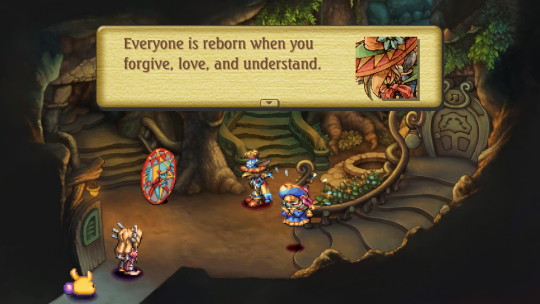
And another noteworthy sequence:
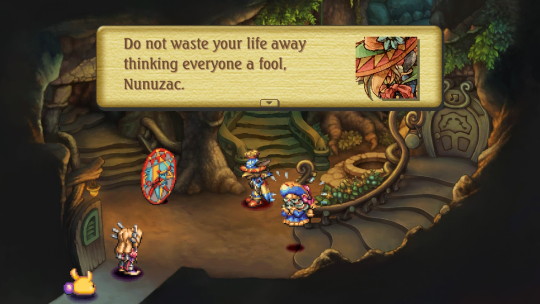

...I just realized, I loved Legend of Mana ever since I was a kid, and I wonder if unconsciously, this was one of the things it instilled into me? That this beautiful world is indeed full of tragedy, but we aren't here to just curl up and despair. We're here to celebrate that beauty and share its love with everyone else.
And this sort of thinking appears in a lot of my favorite media: the Legend of Zelda (Courage is never forgotten; a single person spreads hope even in an hour of darkness), Natsume's Book of Friends (people in this world will love and accept you for who you are; be kindness to one another), Mushi-Shi (human or Mushi, we're all doing our best to live, and though alien to each other, there is beauty to be found in the other), and Ancient Magus's Bride (it may not be what you feel at the moment, but hold onto your life, hold onto it with fingernails - there is a home for you, too). FGO is also pretty blatant about this, I mean, the game is "take back humanity's future" and with that, "there is worth to humanity's journey." Splatoon as well, has a core message of "celebrate life and colors."
I guess, basically, my most favorite/comfort works has this say: despair seems natural in this world, but it doesn't have to be.
(wow that got long, move onto the next screenshot)
Lastly from Pokiehl, in "Legend of Mana."
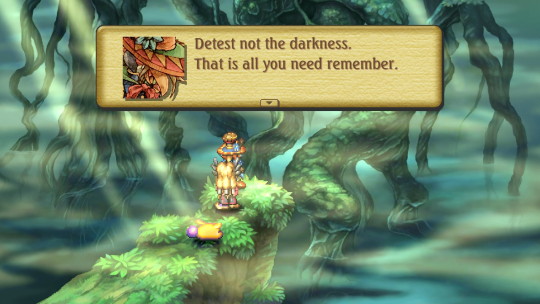
Now onto another Wisdom - Tote! I'd say he's my second most favorite wisdom, I love just how chill he is, and he's simple. He's just a turtle, but one that lives a good life.
From "In Search of Faeries"


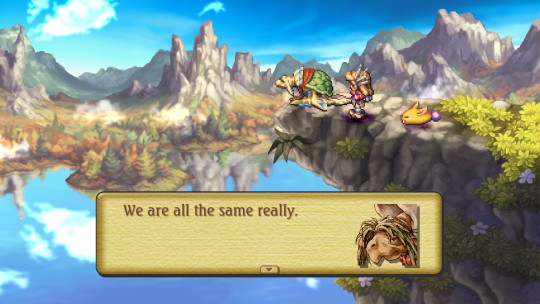

Onto my other most favorite NPC, Monique, from "A Siren's Song,"

It's such a simple statement, but the power behind it, and the scene for it bowls me over to think about.
And another from "The Spirits' Light"


Lay into him Monique!
Now here's our other resident siren, Elle, and her talk with Gaeus:



And lastly, Vadise from "The Crimson Dragon"


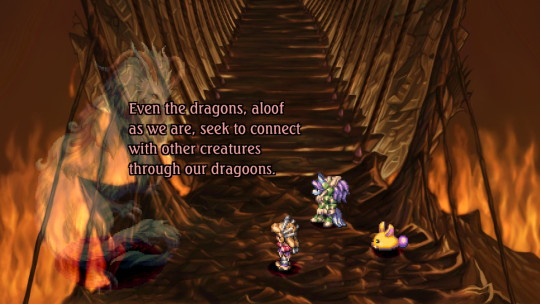
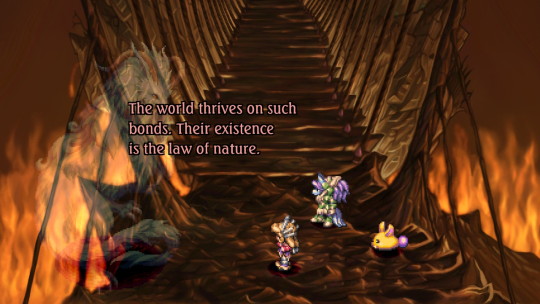
....ooof, I just realized, too. Vadise insistently uses "bonds" and the track that plays when your arm is twisted into working for Drakonis, is the rather melancholic version of the main theme for this arc...is "A Bond Bestowed". I'm not completely sure, but it may have been named "Bondage Bestowed" in the PS1 release, which is more accurate to the situation - you had no choice but to work with Larc because you had been dragged into the Underworld and turned into a half-spirit.
So Vadise uses "bond" here as to how it should be - connection to others that comes about out of kindness, not manipulative as Drakonis had been. Though, comedically, gameplay-wise completely NOTHING stops you from not going through with the dragon arc and screwing over Drakonis that way - to unlock the Mana Tree, only one of the main three story quests need to be finished, so if one so chooses they can either complete Star-Crossed Lovers or Jumi Arc and then jaunt on over to the Mana tree despite being supposedly half-dead lol.
There's waaaaaaay more poignant scenes, of course - I just talked about "Can't Look Back", which is all about grief and losing loved ones, and "Diddle's Had it!" is another big quest full of "we're here, and let's live life!" And of course, the Jumi Arc is filled to the brim with heartfelt story scenes.
So this long ass post really is just a small collection of these moments.
What would you say is a dialogue line from LOM that stuck to your mind?
36 notes
·
View notes
Text
A very long UTDR Theory
I think I figured out something, or at least cleared out some subconsciously-aware-but-not-fully-established connections regarding UT&DR(, which I have a feeling some of the utdr community knows already and I'm figuring this out just now, but imma still post to clear my thoughts for a bit).
Remember how the Undertale official website says Deltarune is intended for ppl who's fully finished playing Undertale, and that Toby Fox made Undertale as an introduction game to Deltarune, and the 2 games can't be seen as mutually exclusive?
I feel like I understand these 2 statements a bit more now, what I think Toby is saying is that,
The whole of Undertale is The TutorialTM for Deltarune.
There is another reason(besides color theory) why battle encounters are in black and white, Undertale itself is a relatively very black-and-white morals and rules kinda game.
Everything's very clean-cut, it's either right or wrong, righteous or evil, etc etc. just like what you would see in a children's book or a children's mindset.
But in Deltarune, there's no black&white battle encounters anymore, or at least not much of black and white places, because similar to a teen's mindset, it's more developed/enriched & grown up to be able to see the world in more different shades of colors, hence the colorful battle encounters.
You are also technically told you're given more freedom but reality tells you it's actually quite limited (examples: Jevil in a cage thinking he's free, Spamton bound to strings of someone else's control and getting even more trapped from resisting, Kris's whole soul-controlled-by-player situation, Susie denying the choice option twice), just the vibe one gets when exploring expanded range of choices, learning & dealing with its following consequences.
Think of Undertale as a children's story book, for children like Frisk's age, to understand basic concepts;
while Deltarune is kinda the early teen novels, for Kris's age, to understand more advanced concepts.
But then why is this important for what's happening in both games? Why does it matter?
Toby's using Undertale to teach us how to play Deltarune.
Remember how in all 3 types of routes, Flowey, Sans, & Chara(coincidentally red&yellow&blue colored) all have something important to say directly to the player, not Frisk?
They are the 3 Messengers, or, the 3 Big Blaring, Warning Signs who carries the messages/warnings sent from Toby Fox to the Player.
And the most prominent message that all 3 convey is this: You are not above consequences in his games/fictional worlds. All actions have consequences, and you have been fairly warned, multiple times(e.g. Chara's whole appearance sequence in Geno route & the photo post-Geno Pacifist route, Sans' judgments & phonecalls & diner meetings, Flowey's tips about what could be done to achieve Pacifist route after Neutral runs & the talk about how Sans gave him a bad time for being cruel in previous resets not unlike a time police; in short, the signs were always there in all routes).
And the game Knows what you are in the dark.
There is also a slightly more specific message per each character:
Flowey: You are given the freedom to make choices in this(my) world(especially the power to Save, Load, Reset &/ Maim), but beware, your actions will have consequences.
Sans: If you treat us(my characters&world) with respect, you'll have an enjoyable journey as a reward. (Also that he embodies the "Don't forget"&"I'm with you in the dark(to watch over&on you)" side of Toby & his games)
Chara: But be warned, you will be punished for unnecessary cruelty via crap gameplay experience. The Choice is yours. =)
(Granted, the 3 characters technically overlap in some of the messages but these are what is most linked themes/message to the respective characters)
Going into Deltarune, The game in general(or Toby, in a way), tells us "your choices doesn't matter."
This is where the "Undertale sets up the groundwork for Deltarune" part comes into play: (yes, it was also to introduce you to some of the characters first so Toby doesn't hafta info dump you on whomst-the-fuk all these characters are, but that wasn't the only reason for it)
The choice has always(mostly, actually) been yours.
Then, do those choices matter?
The answer is both Yes and No, depending on how you view the question, as it is vague in a way that it could be interpreted in more than 1 ways, which is where the thinking trap is.
If you interpret it as "our decisions & actions will not change the ending of the game", then Yes, I personally believe it doesn't change the ending.
BUT, If you interpret it as "our decisions & actions won't affect Anything in game", then No, it does affect a lot of things(besides the final ending, is what I think).
There is already a Pacifist vs Snowgrave route that can be caused by our choices, the game doesn't railways everyone who plays the game to go on the same route. There are even more examples, like how others respond to Kris's ooc-ing and out-of-norm actions, character relations, and so on, but I'll stop here for examples cuz it will go on and on, eitherway the point stands:
The answer to "Does our choice matter?", in my opinion, is "No(it very likely doesn't change the final ending), but also Yes(choices affects certain parts of the game, e.g. routes, gameplay experience, etc.)"
The problem with the question the "choice doesn't matter"statement poses is that it is such a Yes and No question, that for people who have played or experienced Undertale,
it is giving mixed signals and befuddling people, especially to the ones who aren't fully aware of the important theme(s) of the predecessor game(Undertale), or is unable to respond to the unspoken question in more than 1 perspective as seen above.
With so much seemingly conflicting and confusing information floating about, it is easy to forget that the core message, or rather the somewhat non-outright spoken rules Toby's wrtten into Undertale still applies in Deltarune, which is likely why "Don't forget" is also such an important line that goes from Undertale all the way to Deltarune, cause Toby's reminding us to not forget about what was taught from Undertale about treating his games and beloved characters right and do the same in Deltarune. (He does seem to love his concepts aka the games he created a whole lot & put a lot of thought into it, even makes sure the players don't get away scoot-free if they intentionally harm his characters, it feels pretty much same with UU's mangaka who also loves their creations a whole lot, and doesn't let even angst for the plot progression to "harm" their characters with angst too much, done in a logical way no less)
"Don't forget, I'm with you in the dark" seem even more personal (and scary, if you weren't behaving in-game *wink*) if we see that as a message from Toby to the Players now, doesn't it? It's also seems kinda a test to see if the players have understood what was learnt in Undertale, & also be able to understand what it actually means in Deltarune. I guess UTDR has actually always been kinda like a mind game in a way.
Congrats for reaching the end of the post! Here, have a complementary meme template.
#me, @ UTDR players:

#undertale#deltarune#utdr#utdr retrospect#utdr theory#guys Toby's yiteing us into kindergarten and then elementary#in this essay i will#long post be warned
4 notes
·
View notes
Text
"The Fantastic Four" (1961, issue 1)
Not every issue deserves its own post, but I think the very first one does. It's a goldmine of insight into this age of comics.
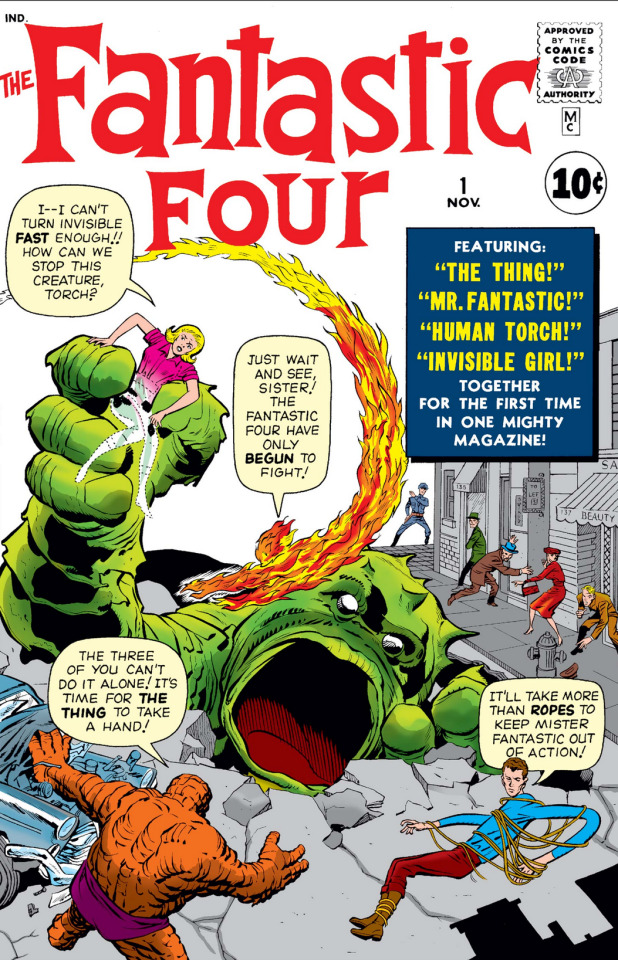
Lookit that, our very first comic book cover! I dig it, except for the part where I didn’t realize where the Human Torch was in this image immediately and so it briefly looked like the monster was speaking. And also the part where the Invisible Girl turning invisible doesn't seem like it will help her. And also also the part where the depicted scene doesn't happen in the story.
Going into this, I should probably clarify that I know next to nothing about the F4. I do know their names and powers:
Reed Richards, under the alias "Mister Fantastic", is the leader who can stretch any aspect of his body to incredible lengths. He's also a really smart inventor, to the point that the Reed Richards Is Useless trope is named after him
Sue Storm, alias "the Invisible Girl", can... turn invisible. And get captured a lot.
Ben Grimm, aka "the Thing", is super strong and super tough.
Johnny Storm, aka "the Human Torch", is Sue's brother and can burst into flame for a limited duration, gaining flight and pyrokinesis.
Also, Sue and Reed will be married and have two kids (one of whom is nigh-omnipotent?), the Thing is divinely mandated to never return to human form, in the multiverse there’s a “Council of Reeds” and also an evil Reed called the Maker who can elongate his brain to get smarter, and the F4 used to be the most popular Marvel heroes. All that out of the way, let’s dive in!
Huh, you could buy this for 10 cents. I wonder how expensive that is in today money…? $1.03. Wow. Also, does anyone know what that M C label between the CCA stamp of approval and “10c” means? Is that just an abbreviation for Marvel Comics?
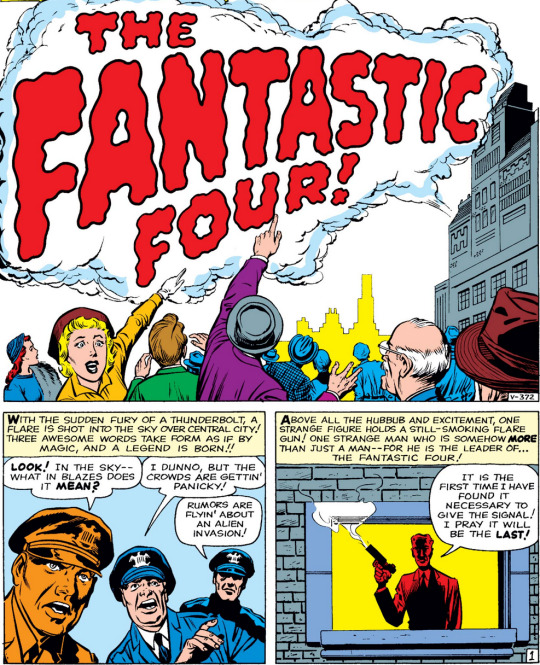
Love the artwork, including the way that the mysterious guy who totally isn't Reed Richards is colored in the bottom right. That flare gun is pretty cool too, what with its ability to form words. Could you imagine having a flare gun to signal your friends like that? Damn.
On the other hand... the cops. Le sigh. I get a feeling we'll be seeing a lot of cops for a long while as symbolic shorthand for justice and goodness. Blech.
First part of this story is the F4 all heading to the flare's location while demonstrating their powers. Basically all of them cause some trouble for the unsuspecting citizens of New York - Sue bowls people over running invisibly thru a crowd, speaks and frightens someone into thinking there's a ghost, and causes a taxi driver to flee for his life after attempting to pay him while invisible; the Thing busts out of a clothing store and wrecks the door, scaring the passerby and causing the cops to shoot him (w/o resulting in harm); and the Torch slags a car on his way over... we'll talk more about the Torch's intro in a bit.
There's no way doors keep being unwieldy for the Thing. It begs the question of how he got into the shop in the first place (possibly he squeezed thru carefully or used a larger entrance, but in his haste just plowed thru the wall), and it's not a particularly interesting antic to show whenever we want to show the F4 unintentionally causing havoc. The whole Thing intro is a pretty effective introduction to his character - actually, they kind of all are. This intro sequence showcases their potential to be menaces and positions them as fantastic oddities within the hustle and bustle of New York; Sue is a little careless, the Thing is grumpy about hiding himself from the world but also doesn't enjoy his strange body drawing attention from the public, and while the Torch may love working on hot rods, he's also a hothead so excited by the prospect of the first F4 mission that he bursts into flame INSIDE the car and melts parts of it into slag before taking flight. A promising start for characterization, I suppose.
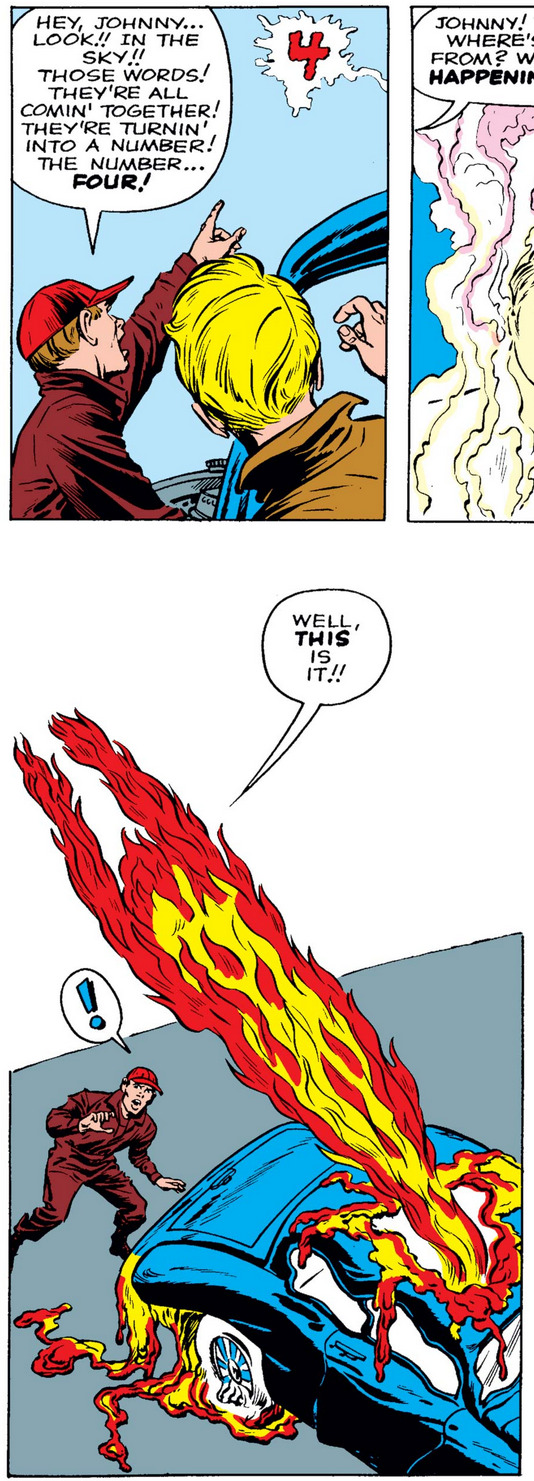
Also, again, the flare gun is SO COOL. You can pre-program it to form sequential messages? Fuck having powers, I want one of those.
Back to the Torch's intro. His appearance in the skies is so disturbing that the government sics fighter planes on the "unknown flaming object over Central City", and here begins the silliness in earnest.

You know how fighter aircraft engage their targets by swooping in like a pack of orcas, to savage their foes in melee combat? Yeah, me neither. Why are they getting close enough that he can saw straight thru them, when he wasn't even able to melt more than a torso-size hole thru a car he was in? It’s that shit in action movies where it feels like the jet pilots are trained to try and bull rush their targets, and it never ceases to irritate me*. That's just the appetizer though. The real silliness is...
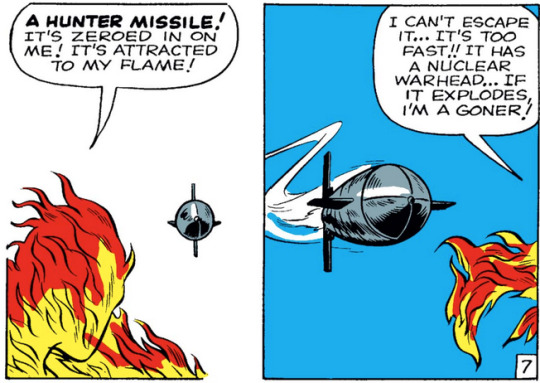
You know how governments LOVE firing nuclear warheads at hostile targets? You know how they LOVE firing nuclear warheads at targets directly above ONE OF THEIR OWN CITIES? Look, I get it was the ‘60s. Of course everyone had nukes on the mind. Of course if you want to shorthand “really powerful kablooey” you just say “nuke”. But what immeasurable stupidity this is! Why, they oughta sack the officers that gave that order! Now the obvious fix would be to just... not call it a nuke. But our task is not to control, but to see, and so we bear witness to the first of many terrors running rampant in the Marvelverse - nuclear weapons getting used all the damn time.
…And then Reed stretches his arms up, catches the warhead, and flings it into the sea to explode. Thus starts the long trend of “safely” disposing of nuclear ordinance by lobbing it into the water. Thus also appears an unstated but consistent property of Reed’s super-stretchiness: he can arrest the momentum of things much stronger and faster than he by grabbing or grappling them, and then throw them the fuck away despite lacking the apparent necessary leverage to do so. Unlike my prior umbrage re: jet fighters and nuking one's own cities, I actually have no problems with this - as long as it’s internally consistent, I don’t really give a shit that a superhero-verse has different physics than ours, and I find the insistence that their physics MUST match ours to be nonsensical. If that really upsets you, I got bad news about basically every superpower.
After that follows a flashback to the origin story of the F4 - they stole aboard a rocket and piloted it to space so that AMERICA (THE BEAUTIFUL, GOD SHED HIS GRACE ON THEE) could defeat the vile commies (better DEAD than RED!) and make it to space first... but they hit some sort of radiation zone... crashland back to Earth... and discover they've all mutated in some way. After that comes their actual first adventure: Reed has discovered that nuclear powerplants across the world are being claimed by sinkholes, they fly to the mythical "Monster Isle" to track down the perpetrator, fight some random monsters that aren't really worth writing about (and Reed again demonstrates that he can lift really large objects and throw them into the sea), they fall into the center of the Earth and meet "the Moleman"... the Moleman, who I vaguely recall is going to reappear in some future Marvel comics, is apparently a hideous-looking guy who was shunned by society, fell into the Hollow Earth and became the blind leader of its monstrous creatures, and now plots to overthrow the surface world by first depriving them of their powerplants. He also has a "radar sense" that makes him an exceptional hand-to-hand combatant - basically spider-sense. Yeah, not a great villain, and not a particularly compelling adventure if you're looking for anything more than cheap thrills.
Nevertheless, the story is a fun read, and justifies its price (which is admittedly 'free', in my case...). It's pulp for kids, OJ optional. It makes for a great introduction into the Marvelverse, and if this was your first superhero story ever I think it would be pretty neat, but the actual adventure is bleh (weren't threats from the Hollow Earth already getting stale by the 60s?), and Sue and Reed don't have much character beyond "heroic do-gooders".
*What bothers me is not a lack of fidelity to actual military operations. What gets my goat is the lack of conception of distance that this particular cliché indicates. It’s why I also get pissy when fiction treats different celestial bodies as practically next door, trivializes what travel distances are like for people who don’t have cars or commercial jets at their beck and call, etc. Distance matters! It's an important factor influencing human history and our individual lives, and it can greatly enhance the texture and stakes of a story! Don’t just foo-foo it!
#hrm liveblog#the fantastic four#marvel comics#cover scene doesn't happen count: 0->1#superfluous atomic weaponry count: 0->1#dump a nuke in the ocean count: 0->1
3 notes
·
View notes
Text
"This fight isn't over yet, Captain No-Hair."
I've gone on record about enjoying when the Viz translation goes off-book, and I maintain that "WHAT IN THE WIDE WORLD OF SPORTS" is one of the best lines in the whole series. I think it's a fun way of bringing in the roughness of the speech in Japanese that doesn't necessarily have a direct translation in English. But I actually wish that liberty hadn't been taken in Ichigo's line here:
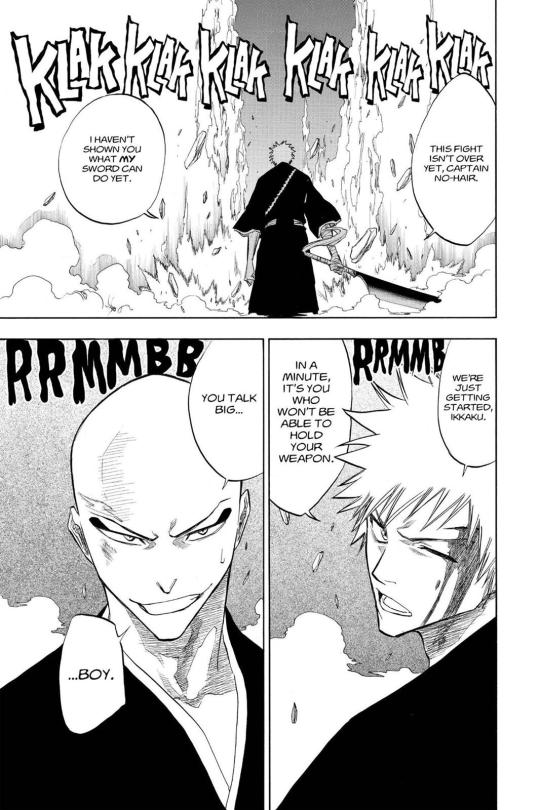
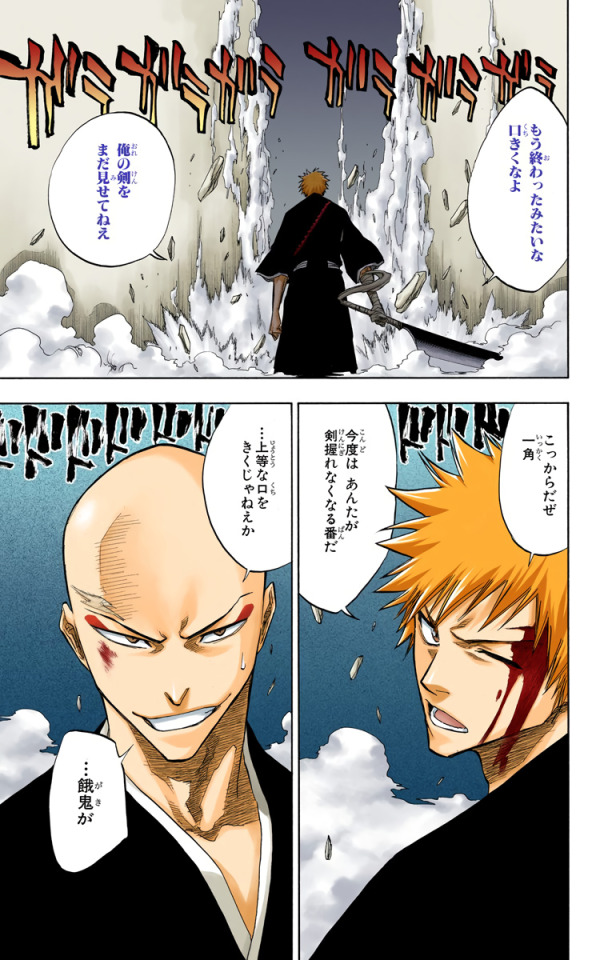
[Bleach 087]
In the Viz, Ichigo's line is, "This fight isn't over yet, Captain No-Hair." I'm not really sure why Ichigo decided to be Colorful right at that moment? Especially since the reference to "captain" is a bit confusing, given that 1) this series really does have captains, and 2) Ichigo doesn't really give a damn that this series has captains. Anyway, in the JP, I would translate the line, "Don't talk like this is already over."
And I really love that line, because "talk" is a repeated motif across their whole fight, and I feel like that line is a big part of why Ikkaku ends up liking Ichigo. The point of the line is that it's not a cheap taunt. Let me back up:
Ikkaku does his Lucky Dance and sings his Lucky Song, which he says was supposed to give Ichigo and Ganju time to run away. But Ichigo doesn't run, even though Ikkaku notes reiatsu-wise he outranks Ichigo. But Ichigo figures, if Ikkaku's really that much more powerful, he'd just run Ichigo down, anyway. If they fight, then they'll see.
Ikkaku asks for Ichigo's name, just in case. And says that "Ichigo" is a good name because names that start with "I" are good--like his, Ikkaku. (So begins them calling each other by their given names.) This is no longer some anonymous street brawl with a ryoka--it's Ikkaku vs. Ichigo.
Ikkaku quickly figures out that despite the fact that Ichigo is most definitely not a soldier he moves well, and he's been trained by someone. Once Ikkaku learns that Urahara was the one who trained Ichigo, he releases Houzukimaru's shikai, so he can kill Ichigo the right way.
That's when Ichigo says, [1] "Don't talk like this is already over." And I feel like Ikkaku really responded do that, because Ichigo kind of calls him on the grandstanding. Like, hey! Don't act like the fight's over when there's still fighting left to do. Stay in the moment! Take this seriously. Respect what we're doing here! Which seems like something Ikkaku probably lacks for in most rights, and would find really refreshing and invigorating in Ichigo.
It also jibes with Ikkaku ultimately not wanting to end the battle unless it ends in death--that is, not acting like that fight is over until it's over over (even if Ichigo ultimately backs off that particular idea).
When Ikkaku says [2] "Aren't you a big talker," he parallels Ichigo's own grammatical construction; they both use an adjective/adjectival phrase to describe a 口--mouth/way of talking. And Ikkaku keeps it up later, when he cajoles Ichigo, [3] asking if it's just his mouth that was skilled:
もう終わったみたいな口きくなよ (Don't talk like this is already over.)
上等な口をきくじゃねえか (Aren't you a big talker.)
威勢のいいのは口だけか? (Are you all talk?) [even more liberal translation than usual; I couldn't get this to not sound dumb]
I feel like this whole extended "talking" motif is important because it's playing in parallel to the Soul Society Yumichika is simultaneously describing to Ganju, with the gladiator pits (like Ganju needed more convincing that shinigami were bananas). I have received the message loud and clear that I am in the minority when it comes to my interest in the gladiator pits, but too bad!! we're going to talk about them more!! The Pits are so important! They serve as foil to this Ikkaku-Ichigo sequence. They present one characterization of the Seireitei and Ikkaku another, with his styptics and his personality and his name and his intelligence in sizing Ichigo up, and his willingness to tease out what Ichigo's about.
And Ichigo gives Ikkaku just as much--it's immediately clear to Ikkaku that Ichigo is no criminal mastermind (though he is in kahoots with one, re: Urahara), nor is he some bloodthirsty hoodlum. And, importantly, he's no soldier.
In contrast to the lurid spectacle of the Pits, Ikkaku and Ichigo recognize each other's personhood--their training, their wisdom, their names, their senses of battle honor/procedure. And even if Yoruichi thinks Ichigo is bull-in-china-shopping this (and he is! a little! they got here via CANNON), he's a pretty smart bull. And so is Ikkaku--he knows what Ichigo is and isn't.
(I don't think Ikkaku ends up sharing any of this intel--or at least, any of the juicy bits--even though it's info I feel like at least half the people in this arc would have really appreciated. Especially since what flys around instead is "the ryoka beat IKKAKU" which surely did not lend itself to an atmosphere of measured calm lololol. But hey, Ikkaku's here for the smiles per gallon, not the Sake of the Seireitei.)
#believe me i didn't have 'ikkaku and ichigo form a friendship based on rhetoric and grammatical parallelism' on my bingo card either#madarame ikkaku#kurosaki ichigo#bleach manga#bleach reread 2021#bleach カラー#bleach language#no brain just bleach
18 notes
·
View notes
Text
Don't get me wrong I love the show so very very much and I'm so happy it exists, but it definitely has some issues. And personally I think most of the issues are just that it isn't long enough.
It feels like there have been so many moments where the writers wanted to include something from the books, but just didn't have the time or budget or whatever and they did the best they could.
Crusty, Cerberus just acting like a large normal dog, Charon, the Kindness Animals, Luke training Percy, Iris messages, Percy's water power. It feels like there are so many things that were included, and I'm so happy that they were, but they weren't nearly enough.
Definitely doesn't help that they're also speedrunning every mystery part of the books. Like yes it is very obvious that "Aunty Em" with a statue emporium is Medusa, but I'd much rather they make it less obvious over making the characters instantly recognize her. Same with the lotus hotel and crusty.
I love the writers so much and I think they're doing an incredible job, I just wish Disney gave them more than 8 35-40 minute episodes. It could have been so good with somewhere around 12-15.
We could have had an entire episode of Luke trying to help Percy figure out his gifts, they could even introduce the whole "water makes him a better fighter" thing from the books that they've fully ignored so far (?). They could have gone to the casino halfway through an episode and it could've been played almost like a horror sequence. Maybe end with a cliffhanger of percy and annabeth walking past each other with no recognition or something and they don't escape until the next episode. Give them more than 12 minutes to learn about the threat and also overcome the threat.
13 notes
·
View notes
Text
A summary of Homestuck: Acts 2-3
by someone who keeps reading it despite warnings
Part One: Jade
I'll summarise the intro to Act 3 and then delve into the two newly introduced character's stories individually. If I write any more, my gecko head will implode.
Let's start... somewhat simple.
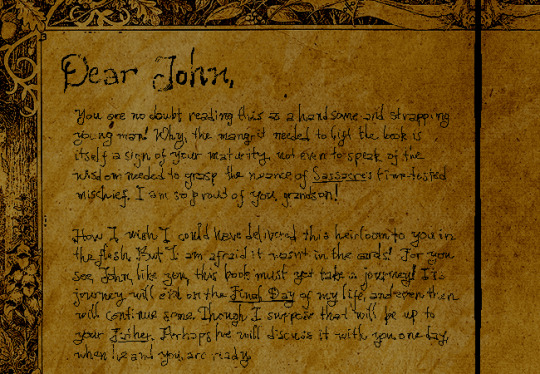
We get a written message from John's nanna (whose ashes fused with the kernelsprite last time) in his dad's copy of the Colonel Sassacre book, saying that he's becoming wiser and can grasp the nuance of the book. There's also a lot of stuff about a prophecy, and Timeless Expanses, and Kernelsprites, etc. After that, we get the true beginning of Act 3.....
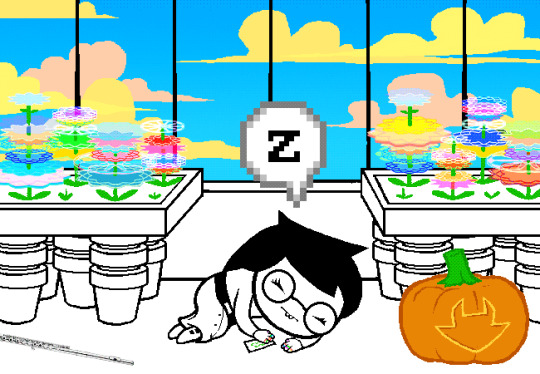
an eepy.......... This whimsical girl's name is Jade Harley (most definitely not Farmstink according to her letter). She's got quite a bit of interests, most prominently her small garden and fauna, I think.

After proving that she is the best character with her amazing flute skills and actually doing the asinine requests the audience tells her to do, she goes upstairs to her bedroom.
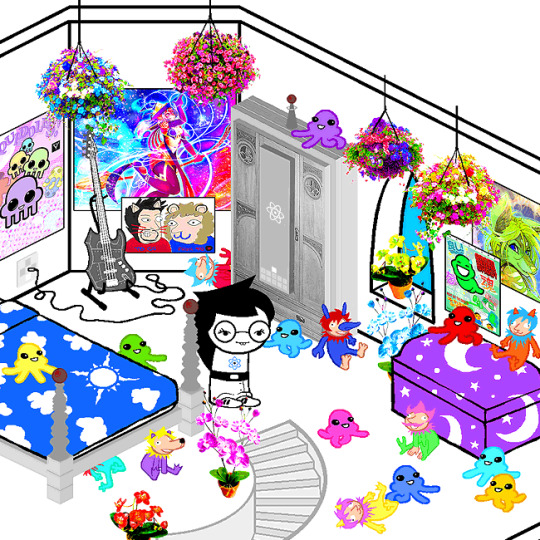
She plays some bass, cooks up something for her pet and then pesters her friends for a bit (she is GG, the green text chatter from earlier in the comic). This is set sometime at the beginning of the story, as she pesters John with a birthday message.

Rose pesters her about if today is the right day to play a fun game that would help "answer some questions". Jade gives some optimistic word of advice, then hops off Pesterchum and descends to the lowest floor of her house (house? observatory?).

She encounters this thing. It is hideous and I'll leave it at that.

After getting a "troll message" (I wonder if these guys will appear later?) she scampers into the grand foyer and gets herself a rifle. For being the "cutesy" character, she knows pretty well to keep herself strapped.
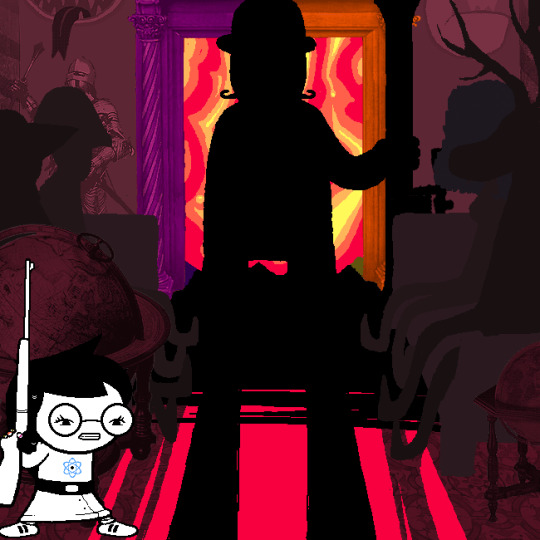

After an encounter with her strict robo-granddad, she goes out on her big ol' island to find her devilbeast to feed it, with no such luck yet. She notices that the birthday package from John finally arrived near the crumbling monument. But before that, she has to get past the devilbeast itself, Becquerel!!!!!
youtube
(These battle sequences are getting real elaborate, you can tell Hussie's putting a lot more effort into these)

(We also get a song composed by Andrew Huo and a complete unknown. I wonder what he'll do later?)
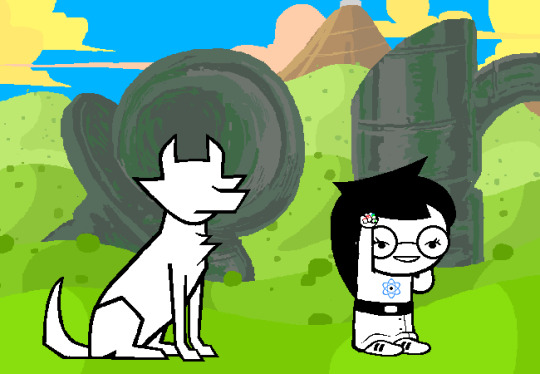

After a wholesome bonding moment between Jade and her favourite beast, she goes eepy yet again and Bec takes her back to the bedroom, where she begins to dream through the power of her Dreambot.


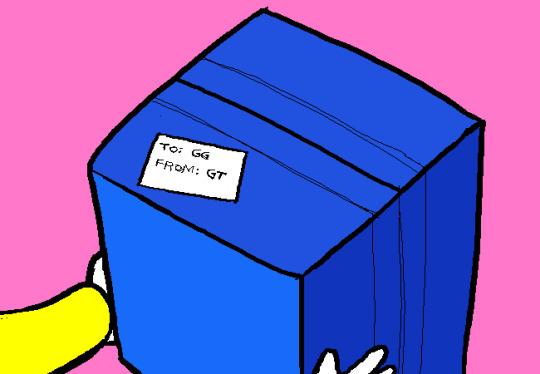
She doesn't open this package just yet, as what she does is send the package to her past self by sending it to the Wayward Vagabond in the future, who promptly gives it to Peregrine Mendicant, who promptly sends it to Jade's past self. Wibbly wobbly indeed.
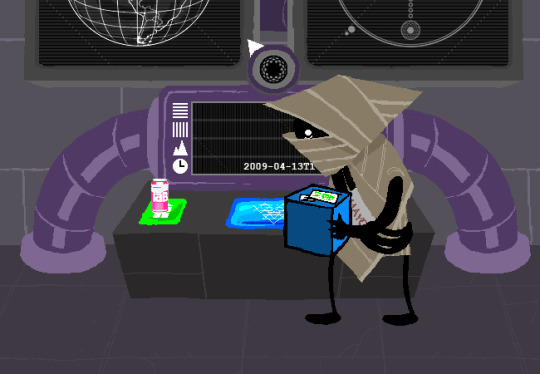


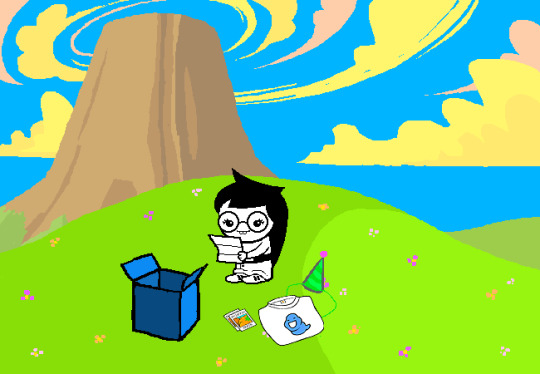
Anyway, back to present Jade. She's got a whole dream city to explore!
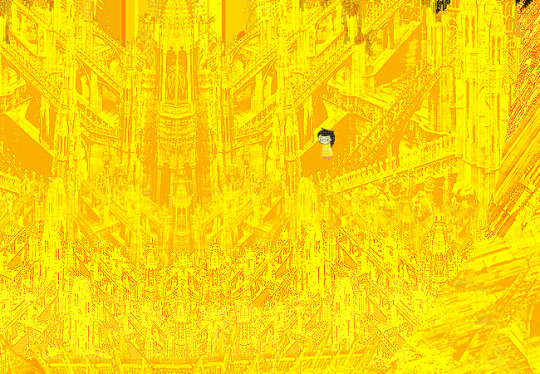
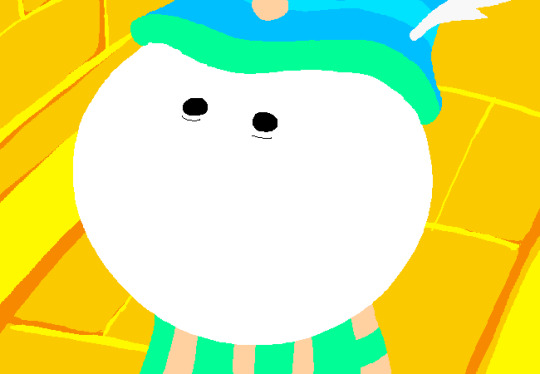
She encounters a dream friend, who kinda looks like Peregrine? Might be.
Afterwards, Dream Jade decides to inspect the neighbouring tower, home to Dream John Egbert, who is sleeping.
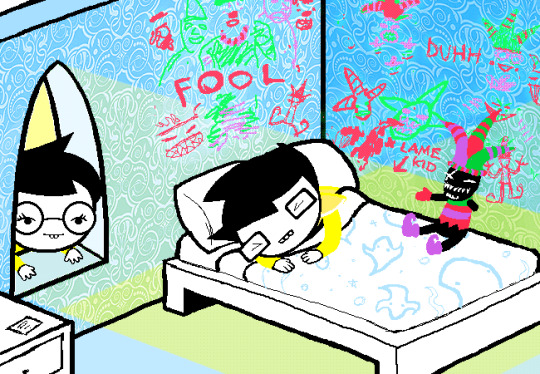
She wonders if he ever ended up getting his birthday present from her, but she better get inside before the Dream eclipse occurs (is this another world entirely or just a dream hub?)
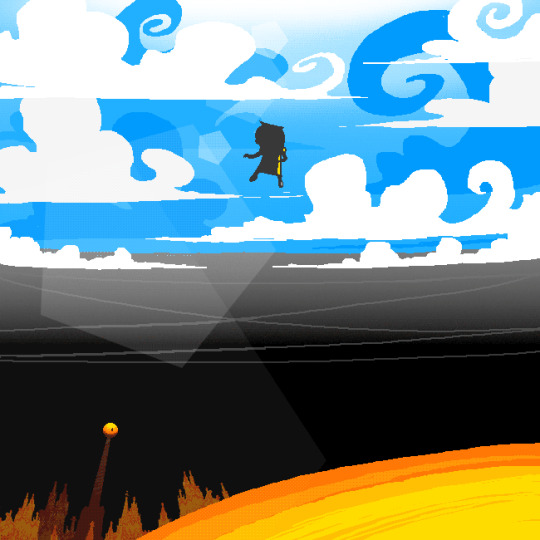
youtube
She pesters John about the gift before a large noise occurs outside her house, which she goes to investigate but Bec stops her from doing so (deeper motivation maybe?). After that, it's revealed that Jade's gift was the one in John's dad's car which was dropped off the cliff some time ago.
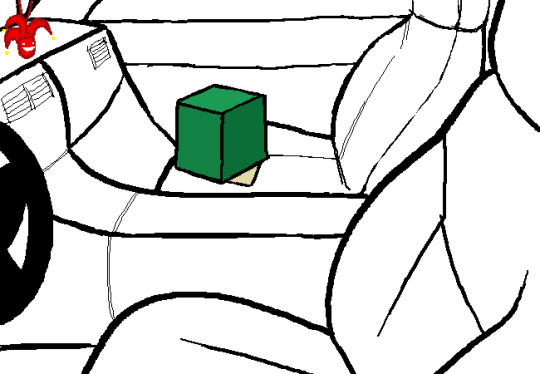
(this one) John then catches up Jade on everything that's happened to him thus far (meteor blowing up his neighbourhood, can't find his dad, Rose losing battery power, etc.) Jade encounters John in the Dreamworld, then they both wake up simultaneously.
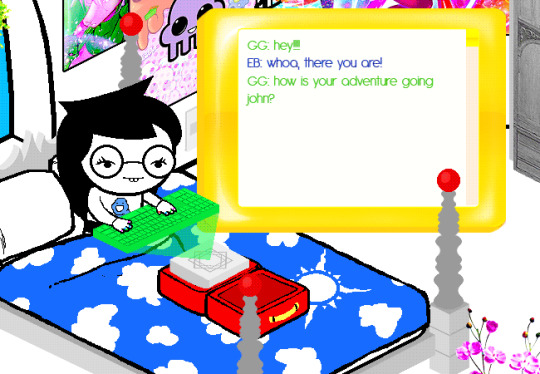
She then pesters John in the real world, saying that
GG: well..... GG: its hard to explain!!!GG: but...GG: i know what it is now!GG: and now i know everythings going to be ok!!!
Apparently she's had quite a few premonitions, and this very dream suggests she needs to go to the Mystic Ruins. Harpoon in hand, she makes her way down.
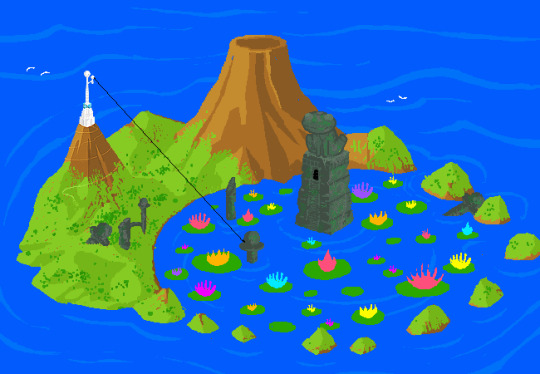

She places John's present in an exact spot and writes a letter to the future WV. The present suddenly disappearifies due to what happens in the future.
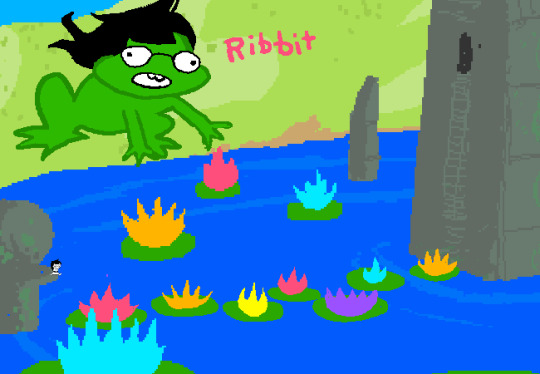
Jade leapfrogs her way to the main tower of the ruins (complete with beautiful artistic rendition by Hussie) and heads inside. On page 1148, she finds a flower timer thing that is definitely related to SBURB, watches it appearify Dave's copies of the beta, and that is where her part of the story ends for now.

Asides from her being a cryptic, Jade is such a fun character to watch. Her excited reaction watching the Tangle Buddies, her rather eccentric bedroom, and the weird cyberspace she gets into while on Pesterchum are all very good examples of 'show don't tell' instead of 'this person is very weird and whimsy'. She is showing signs of knowing more than she lets on, which will be interesting to see play out later.
Anyway. Be the cool guy.
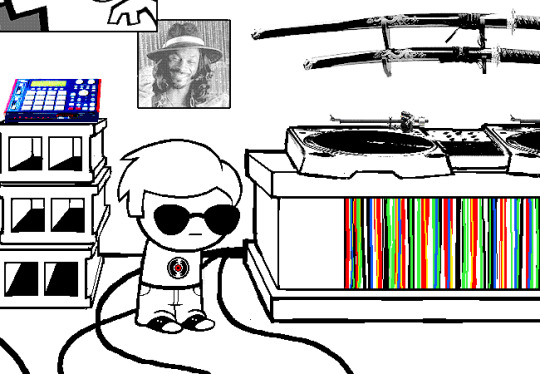
My man.
34 notes
·
View notes
Text
Unlock Your Marketing Potential: Powerful Tips for an Effective Content Strategy
At Imagency Media, we understand that a well-crafted content strategy can be the key to unlocking your brand’s full marketing potential. In today’s competitive landscape, simply creating content isn’t enough—you need a strategic approach that aligns with your business goals and resonates with your target audience. Here are some powerful tips and guidelines to help you craft a content marketing strategy that delivers real results.

1. Document Your Strategy for Success
The foundation of any effective content strategy starts with clear documentation. Without a documented plan, your efforts can easily become disjointed and less effective
.

Set Clear Objectives: Define your content marketing goals. Are you looking to increase brand awareness, generate leads, or establish thought leadership? Your goals will guide your strategy.
Understand Your Audience: Develop detailed buyer personas to gain insights into your target audience’s needs, preferences, and pain points.
Map Out Content Types: Choose the types of content (blogs, videos, infographics) that align with your goals and audience preferences. For instance, if you’re targeting tech-savvy entrepreneurs, consider creating in-depth whitepapers and how-to guides.
Create a Content Calendar: Plan your content schedule in advance to ensure consistent delivery. This not only keeps your audience engaged but also helps you stay organized.
2. Amplify Engagement with Video Content
Video content is a powerhouse when it comes to capturing attention and driving engagement. Here’s how you can incorporate it into your strategy:
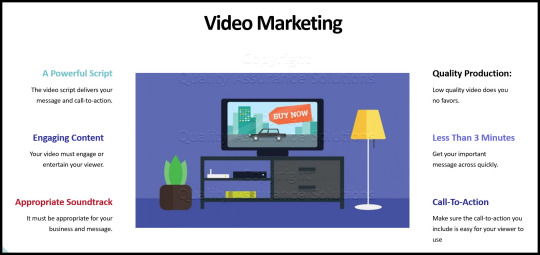
Explainer Videos: Simplify complex concepts with explainer videos. For example, a short video on how your branding services can transform a business can be more engaging than a lengthy article.
Customer Success Stories: Showcase real client testimonials in video format to build credibility and trust. Hearing positive experiences directly from satisfied clients can be a powerful motivator for potential customers.
Educational Tutorials: Offer value through educational videos or webinars. Whether it’s a tutorial on the latest design trends or a deep dive into the benefits of a strong brand identity, educating your audience builds trust and positions your brand as an authority.
Share on Social Platforms: Leverage platforms like YouTube, Instagram, and LinkedIn to share your video content and reach a wider audience.
3. Build Lasting Connections with an Email Strategy
Email marketing remains one of the most effective channels for nurturing leads and driving conversions. Here’s how to make the most of it:

Segment Your Audience: Personalize your emails by segmenting your list based on demographics, behavior, or interests. This ensures that your messages are relevant and timely.
Send Value-Packed Newsletters: Keep your subscribers engaged with regular newsletters. Include tips, industry news, and links to your latest blog posts or case studies. Don’t forget to add a compelling call-to-action to drive further engagement.
Automate Lead Nurturing: Set up automated email sequences to guide leads through the sales funnel. For instance, after a lead downloads a resource, follow up with a series of emails that provide additional insights and highlight your services.
Analyze and Optimize: Continuously monitor your email performance. Track open rates, click-through rates, and conversions to identify what works and what doesn’t. Use this data to refine your approach.
4. Educate Your Audience to Establish Authority
Educating your audience not only builds trust but also positions your brand as an expert in your field.
Create Insightful Blog Content: Regularly publish blog posts that address your audience’s pain points and offer solutions. For example, a post titled "5 Branding Mistakes to Avoid" can attract business owners looking to strengthen their brand.
Develop Comprehensive Resources: E-books, whitepapers, and guides provide in-depth information that your audience can refer to over time. Offering these resources in exchange for contact information also helps you generate leads.
Host Workshops and Webinars: Interactive sessions, whether in-person or online, allow you to engage with your audience in real-time. A webinar on "Effective UI/UX Design Practices" can attract those interested in improving their digital presence.
Share Quick Tips on Social Media: Regularly post bite-sized tips and insights on platforms like LinkedIn and Twitter. This not only keeps your audience engaged but also drives traffic to your website.
5. Boost Reach with Paid Promotion
While organic content is crucial, paid promotion can significantly expand your reach and accelerate your results.

Utilize Social Media Ads: Platforms like Facebook, Instagram, and LinkedIn offer highly targeted ad options. Promote your most valuable content, such as videos or in-depth articles, to specific audience segments.
Invest in Google Ads: Google’s search and display ads can help you reach potential clients actively searching for services like yours. Use retargeting ads to bring back visitors who have shown interest but haven’t yet converted.
Explore Sponsored Content: Partner with industry influencers or authoritative blogs to publish sponsored posts. This can increase your credibility and expose your brand to new audiences.
6. Measure, Optimize, and Re-assess for Continuous Improvement
No strategy is complete without regular evaluation and optimization. Here’s how to keep your content marketing efforts on track:
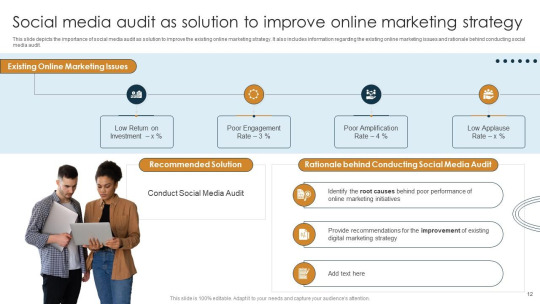
Track Key Metrics: Identify the KPIs that matter most to your business, such as website traffic, lead generation, conversion rates, and social media engagement.
Use Analytics Tools: Leverage tools like Google Analytics, HubSpot, and social media analytics to monitor your content’s performance. Look for patterns and insights that can guide your strategy adjustments.
Conduct Quarterly Reviews: Schedule regular reviews to assess your strategy’s effectiveness. Identify what’s working well and what needs adjustment. For example, if video content is driving high engagement, consider increasing your investment in video production.
Stay Agile: Content marketing is dynamic, so be prepared to adjust your strategy as needed. Stay informed about industry trends and be ready to pivot to new tactics that can drive better results.
Conclusion: Maximize Your Marketing Success with a Strategic Approach
By implementing these content marketing tips and guidelines, you can create a powerful strategy that not only attracts but also engages and converts your target audience. At Imagency Media, we’re committed to helping you elevate your brand through strategic content that delivers measurable results. With the right approach, your content can become a driving force behind your marketing success. Contact us and visit Imagency media to get more tips .
#digital marketing#social media marketing#digital services#marketing#google ads#branding#content marketing#content creation
2 notes
·
View notes
Text
Ring (1998)
If there's any particular form of political messaging or critique surrounding some aspect of Japanese society present in Ring, it is completely lost on me. Is Ring about the Japanese education system and its failure to provide intellectual liberation and how it instead functions to produce ideal workers for industrial society. Probably not. I severely doubt it. There's no way it could be. What I'm really saying is that Ring is a film that I engaged with as a piece of horror and not in any way outside of that, not that in any way that's a bad thing.

The story predominantly follows Reiko Asakawa, a single mother and journalist investigating a rash of bizarre deaths surrounding the viewing of a supposedly haunted VHS tape which kills whoever sees it after a week. Any doubt she has surrounding the veracity of these claims is quickly cut to pieces after the death of her niece and its connection to the tape. After finding a copy of the tape herself and viewing it, it's then watched by her ex-husband, and then her son. What proceeds is an investigation over the course of a week to learn the truth of the haunted tape, it's origins, and how to overcome the evil that lies within it.
I feel very strongly that as a piece of horror Ring lived up to the hype. What I personally appreciated most was the structure of the narrative. Ring as a story is rather decentralized. While everything emanates from a single source, the tape, the various mysteries that surround it are each respectively compelling and while they're concise they also leave considerable space for speculation and many unanswered questions. Something that's often frustrated me while watching certain American horror films is that the direction of the plot can tends towards the obtuse with long drawn out periods of mystery suddenly interrupted by long sequences focused entirely on the horror. The horror in ring is present throughout the film. The investigation surrounding the tape is punctuated frequently by visions or interactions with the forces that surround the tape. The, now iconic, main antagonist isn't even named till nearly halfway through the film. Sadako to me was an especially compelling antagonist, what seemed like simply a story of tragedy and betrayal enacted upon a young girl is revealed to be something deeper, a story of inhuman hatred drawn from a place of eldritch power.

I feel something should be made clear. Sadako can almost certainly be easily defeated. Yes, she can kill using a VHS tape bound to her hatred. Yes, there are ways that she's able to manipulate reality. And yes, her father may be an incomprehensibly ancient and powerful elder thing of the sea. However, she's a child. I have yet to be defeated by a child and would not no matter how much she crawls along the ground or stares at me very angrily.
Here's how I would defeat Sadako:
If I were say in Japan and found a mysterious blank VHS tape that I thought might be an episode of Lupin The Third and found myself suddenly cursed, my instinct would not be to go to the local library and start sorting through microfiche. The first mistake that Reiko and Ryuji made were trying to go it alone. I would immediately look for an Onmyoji in the local phone book since this is quite exactly their area of expertise. After agreeing to pay him in a crate of Captain Morgan's rum he would help divine for me exactly what I have to do, which if I had to guess would take me about a day and simply point me in the direction of the well. This would leave me with a good 5 or 6 days to try to sort out how to destroy a piece of private property in order to extricate some bones.
At this point I imagine myself and the Onymoji would be at a loss for what to do next so I'd start calling universities around the area and see if I could pick up on anyone researching the Ring phenomenon. After finding a nearby folklorist we'd show him the contents of the tape with his consent and full understanding of what would occur and then he'd suggest we pose as land surveyors to dig up the well on the property. We'd rent an excavator and dig up that bag of bones. While at this point 3 or so days would remain with Sadako free it would become clear that the curse still persisted.
The Folklorist reflecting on an internship spent interviewing the locals of Oshima island during his time in college would recall mysterious runes he saw carved into rocks facing the sea which the elders he met claimed to protect them and the island from whatever lurks in the ocean near their home. With this key piece of information in hand the final plan would come to be. On the last day while waiting for Sadako the Onmyoji would paint my body completely with the symbol of protection of Oshima Island and once Sadako emerged from the television the battle would begin. Her stupid glare wouldn't work on me (I'm not afraid of eye contact) so I'd pick her up and spin her above my head and then drag her across the dining table knocking off all the plates.
With Sadako enraged I'd flee the scene and a high speed chase would ensue. After 15 minutes of driving through sidewalks, blasting through red lights, and finally launching the car off a ramp I would arrive at Tokyo Bay. Sadako would attempt to go for a right hook but I'd dodge, I would then deliver my signature Ephemeral Destruction Paradise Reclamation Clothesline attack which with the power of the protective runes would cast out Sadako's evil returning it to the sea at Tokyo Bay. Now a regular teenage girl Sadako would want what any young girl long denied love and understanding and constantly shunned truly would: a shopping spree at the mall and a makeover.
After getting the leeches combed out of her hair and a new outfit we'd all go out to karaoke where we'd learn that Sadako's singing voice is incredible due to all the time she had practicing while stuck in the well. She'd be discovered by a record label and become a pop star with her hit single うしのどきBOOGIE. Out of thanks for everything she'd occasionally send me one of her royalty checks.

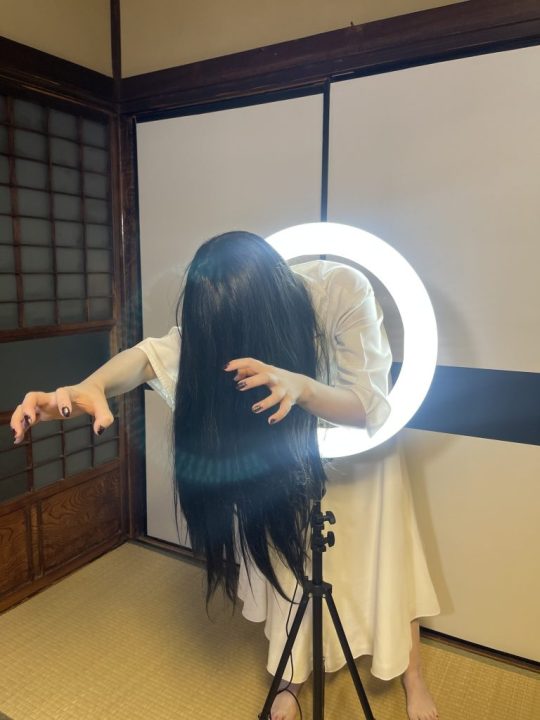
2 notes
·
View notes
Note
Feel free not to answer is this makes you too uncomfortable but do you have anything on number names and their relationship to certain programming (such as number names relating to the role and/or personality of the alter)? I been trying to find resources on this specifically and I can't find any at all so I thought I could ask here. Thank you for all that you do!
There are probably tons of ways to program with numbers.
We have a lot of fragments, and huge portions of them are labeled with alphanumeric codes. For them, it has less to do with roles or cues and more organization. The current theory is that they’re named for their internal locations and initial programming info.
Our fragments are really sorted, most of them are pretty shattered by now and only serve a few related functions. Trauma memory aspects, programming and training, and roles are the categories, and each smallest-level fragment does a fraction of one very specific thing.
There are subgroups that all have low number identifiers. Some are rank based, especially when there’re multiple organizational programs. There are a few who’re numbered by iteration, either of their template or their ‘main’ program.
Cards and polyhedrals come with numbers, and that sorting system can have its own rules. The templates vary in their connectedness, but most of ours are apparently similar. Programs are the same in that they’re usually exact copies from different instances, though sometimes there are updates or large differences.
We also have a board of important alters with numbers, with the smallest as the best. That ties into some externally instigated infighting. The most powerful, respected, dangerous, etc. are titles to win, and the lowest is 0. Negatives mean something entirely separate.
The thing I usually hear about long sequences is that they correspond to internal placement. Grids are pretty common if it’s a shorter sequence, and it might be worthwhile to look at internal structures if you have them.
Chainless Slaves and the Illuminati Mind Control book have combination examples of you’re feeling lucky. I don’t know how mean I’m allowed to be about that coz I do want to see survivors share stories, but I could get some essays out on complaints.
Yeah, I’d look for similarities between the alters who are okay with examination. If they share numbers and an area inside or field of function, that’d be good to know. If you have gatekeepers or internal handlers for numbered alters, even if they aren’t cooperative, there’s good in having past leadership on board with shifting dynamics.
If any of our examples are familiar to you, we can talk more about those. We don’t share details we aren’t safe to, but I feel more secure when it’s direct messaging. We’ll still talk if we can help, just a bit looser lipped in private.
I’ll add this to our notes as something to look for, maybe we can post again if we learn more. As always, good luck, and don’t feel pressured to take concepts that don’t apply to you.
#ramcoa#tw ramcoa#ramcoa tw#ramcoa programming#did osdd#osddid#dissociative identity disorder#polyfragmented system#did system#traumagenic system
8 notes
·
View notes
Text
How Generative AI Is Revolutionizing Content Creation in 2025
In 2025, Generative AI for content creation is no longer a futuristic concept—it's the norm. From blog articles to video scripts, AI-driven platforms are producing human-like content faster and smarter than ever before. Whether you're a marketer, entrepreneur, or creative professional, understanding how this technology works is crucial to staying ahead in the digital race.

What Is Generative AI in Content Creation?
Generative AI refers to systems that can create content—text, images, audio, and more—using deep learning and natural language processing (NLP). Tools like ChatGPT, Jasper AI, Copy.ai, and Writesonic have made it easy for brands and individuals to generate quality written content in seconds.
Unlike traditional automation, generative AI doesn't just replicate—it creates. It learns from millions of datasets and produces new content that’s contextually relevant, grammatically correct, and even brand-aligned.
Types of Content Generative AI Can Create
Generative AI is revolutionizing multiple formats:
Blog posts and articles
Ad copy and sales emails
Video scripts and social media captions
Product descriptions
E-books and whitepapers
SEO metadata and web content
This versatility allows content teams to streamline their workflows and scale without needing massive writing departments.
Top AI Content Generation Tools in 2025
The rise of AI content generation tools has given professionals a whole new content stack. Some of the most used and reliable tools include:
ChatGPT (OpenAI) – For long-form content, dialogue, and summarization
Jasper AI – Known for marketing copy and tone adjustment
Writesonic – Affordable and good for short-form AI content
Copy.ai – Great for ad copy, emails, and brainstorming ideas
Surfer SEO + AI Writer – Combines AI with SEO optimization
These tools not only create text but also integrate with platforms like WordPress, Notion, and Google Docs for seamless publishing.
Benefits of Using Generative AI in 2025
The shift toward generative AI isn’t just about speed. Here’s what businesses are gaining:
Speed & Efficiency
Create blogs, scripts, or ads in minutes rather than hours or days.
Cost-Effectiveness
Reduce dependency on large writing teams or external agencies.
Consistency
Maintain tone and messaging across all channels with ease.
Multilingual Support
AI tools can generate content in multiple languages, expanding global reach.
SEO-Friendly Content
Most tools are optimized to produce content with strong keyword density and readability.
Real-World Applications Across Industries
E-commerce: Auto-generating thousands of product descriptions.
Healthcare: Creating readable summaries of complex research.
Education: Developing adaptive learning modules.
Marketing agencies: Handling bulk content creation for clients.
Startups: Building landing page copy and pitch decks in real-time.
The Future of AI in Content Marketing
The future of AI in content marketing looks promising and intelligent. By 2025, we’re seeing marketers blend human creativity with machine intelligence for unmatched productivity. Content teams now act as strategists and editors, not just writers. AI drafts the content; humans polish and optimize it.
Marketers are also using AI to:
Perform keyword research automatically
Generate A/B testing variations for ads
Create personalized email sequences
Use predictive analytics to improve publishing schedules
This synergy between AI and human input ensures content is not only fast but emotionally engaging and tailored to audience needs.
Challenges and Ethical Concerns
With great power comes great responsibility. There are some challenges that come with relying on AI for content:
Plagiarism Risks: Some AI tools may unintentionally replicate existing content.
Misinformation: Poorly trained models can generate false or biased information.
Brand Voice: AI can struggle to capture nuanced emotional tones or humor.
That’s why human oversight is still essential. Content created by AI should always be reviewed, fact-checked, and aligned with the brand's identity.
What's Next in Generative AI?
Looking ahead, generative AI will become even more immersive and multimodal:
Text + Image + Voice AI tools will become mainstream
AI models will be able to write, narrate, and animate content from a single input
More personalized and predictive content based on user behavior and preferences
AI content writing will be tightly integrated with AR/VR platforms for immersive storytelling
Conclusion
It’s undeniable—AI-powered content writing is revolutionizing how we create, distribute, and engage with content. Whether you're running a solo blog or managing a global marketing team, incorporating AI tools into your content strategy is no longer optional—it’s essential.
By leveraging Generative AI for content creation, businesses can boost productivity, cut costs, and stay ahead of digital content trends. As the technology evolves, so too will the possibilities of creative automation.
Ready to supercharge your content strategy with AI? Start exploring the best tools and techniques today to make the most of this transformative shift! Visit us at https://appsontechnologies.com/ to explore more.
Original source: https://bit.ly/44mIb5A
0 notes
Text
You know what, thinking on that hot take Anon yelling about HBN, no, forgiving MR and not SM/HBN isn't hypocritical, unless you're actively preaching about forgiving MR with the vague message/reasoning of "people do bad things sometimes."
It's because the real case for MR's ability to be a good person and turn around is so much stronger than it is on a surface level. (Wherein the surface level is "ah he's trying to turn it around this time though!")
When MR created ZL chess pieces, he shattered one of his souls. It says so in book 6. So we have this high level sequence of events
Flower implanted -> SM/HBN "dies" -> MR studies forbidden techniques after going mad with grief -> MR starts using ZLCF -> 0.5 MR kills most of the cultivation world and spiral further into madness until he eventually takes his own life -> MR gets a do over
By the time 0.5 MR rose to power as the emperor of the cultivation realm, his souls were so battered and bruised - exactly how many could he have left in tact?
So rather than just ONE affliction, he has TWO —missing souls AND a toxic flower consuming him from the inside out. In addition to the past wrongs committed against him.
The rest under the cut because this divulges major spoilers about the end of 2ha through the story's entirety
MR of all versions was wronged and committed terrible sins in his past when he murdered/took revenge against the Mo family and Mo Nan's lackeys, and he was HEAVILY punished for it in the end at tianyin pavilion when they literally dug his golden core out of his body and he fucking DIED. Like HBN's intention was to execute him for his crimes and CWN saved him, but he still died even after he was swept away to the cottage on the mountainside in seclusion. Even after death he was only a wisp of a soul hanging around with some regrets keeping him from moving on, while TXJ wrought havoc on the world in a decaying body with a stolen spiritual core, pieced together like a ragdoll.
You know who was able to keep their wits about them the entire time? HBN. He was knowingly doing all of this, under the guise of trying to save his people, and ended up paying the consequences when the demon lord crushed him under the gate because there was a single BBBF that HBN was CRUEL toward, in that he literally called to have his spiritual core dug out of his body after driving him to madness in another life by traumatizing him with his faked death and implanting that wretched flower in him. He set 2.0 MR up for disaster and to be hated by all, even more than he already had been in his previous life.
What started as being about just saving the BBBF people became about the destruction of humankind also (I mean it was going to happen even if it wasn't, considering the bodies needed to finish making the bridge and the general concept of, you know, opening the door to the demon realm for anything to get in)
The assault and genocide of BBBFs was never MR's doing, and (unknown to HBN), MR WAS one himself. Partially.
Anyway, before the demon king offers to re..construct? Mo Ran (I don't recall if it was revival or just piecing his souls back together since it's been a few months now), the demon king himself says he wouldn't give a second chance to HBN because his actions were cruel toward the demon king's people (one person, actually, being MR). I don't think anon knows the whole story because there is a WORLD of a difference between the havoc HBN wrought including the extreme suffering and pain he caused to of all versions of MR, KNOWINGLY with all his mental facilities in tact, versus what his pawn, MR 0.5, had done.
In the end, their atrocities were similar, both born from warped minds poisoned by the cruelty of humankind.
The method of poison is different, though both were naturally poisoned, but I truly do not believe MR 0.5 would have gone to the lengths he did had he not A. Crushed his souls to make ZL chess pieces and B. Had the flower implanted into him. Even if he was found out and his past was revealed to all of Sisheng peak, even if his uncle and cousin turned against him in the face of it, and even if SM really truly had died and CWN remained unable to correct the decades-long misunderstanding between them. He would have been bitter, but that doesn't mean he would have committed the crimes that he did, killing innocent bystanders with impartiality and without reservation.
Maybe they think everyone has seen everything there is to know about HBN if you're following the 7seas releases. But I hope they bite their tongue so hard it bleeds when they see what kind of torment MR 2.0 is put through as a consequence of the orchestrations of HBN, and how HBN's actions CONTINUE to pile on to the list of all the reasons someone could hate him for.
I can't exonerate either of them, but HBN gets the ending he deserves because he had SO many chances to turn around and still made so many sacrifices as a means to an end.
I'm not saying he could or couldn't have been redeemable. The choice mb made in the end was her own, and you could call his sacrifice to hold open the door while the BBBFs crossed back over into the demon realm his "redemption". But I would dislike him regardless. It's not an equal comparison, even if MR is only ever so slightly less guilty. I do not feel and should not be obligated to defend HBN because I support Mo Ran and acknowledge I like him despite the crimes he committed.
Hypocrisy is saying HBN deserves to die and MR deserves forgiveness because MR 1.0 "is trying to be better this time." (It almost sounds like trying to defend an abusive ex like, "he's changed!")
What is NOT hypocrisy is comparing the severity and intention of the crimes committed/orchestrated by HBN and MR, and coming to a conclusion that you still dislike HBN for causing this entire sequence of events but still like MR or even TXJ/0.5.
#into the void.txt#ideally i should stop letting myself think about dramatic bs hot take accounts and their patrons...#but god having read the ENTIRE thing changed who i am fundamentally as a person#sometimes i just need to talk major spoilers too.......#even though idk if it still is because like. i dont know how far along vol 8 gets yet#I'm not in a hurry to read yet bc I'm still rereading 6 and 7#and i already know what happens so I'm taking my time
0 notes
Note
Thanks for this amazing answer https://www.tumblr.com/okkottsus/773988123891892225/what-are-your-top-10-favorite-media-ever-can-be?source=share
I totally agree with you! Because for me, most of my favorite media (about 80%) are also anime & manga. 😆😆
I love some of your favorite, too (like Banana Fish, Akatsuki no Yona, Haikyuu, and Attack on Titan).
It's just kinda funny for me, NagiReo is in your fav ship list and Reo is one of your fav character, but Blue Lock is not on your fav media 🤣 (sorry I don't mean anything negative with this comment).
I felt the same thing. Until now, Reo is in my top 10 fav anime/manga character, and I fall in deep for NagiReo (now they have entered my top 10 fav non-canon m/m ships ever), but somehow Blue Lock is not my favorite anime/manga, too. Like for me Haikyuu >>> Blue Lock as a whole.
Sorry for this long ask.
P.s
Do you mind if I ask your top 5 (or top 10) favorite moments from any media that you love (can be anime/manga, tv series, books, movies, games, etc)?
asjdjk no i get uuuuu, tbh i do consider blue lock one of my favorite manga to this day, but its not that high on my list anymore, mainly cause of its latest chapters. i still think it's had a looot of incredible moments (with the u20 match being absolute peak) & i still enjoy most of the characters in it, but i def wouldnt have remained as invested in it if it werent for nagireo
haikyuu has better writing as a whole for sure, but the two manga have completely different approaches & charms too, so i usually dont even bother comparing them
oooo interesting continuation... i think i'll include one moment from each of my top 5 media cause, if i'm being totally honest, i could easily make a separate list just for aot moments 😂 spoilers ahead
1. aot: eren & mikasa's final plead to levi & hange to save armin from certain death instead of erwin. mikasa sobbing and struggling against hange as they tell her that we all have to say goodbye someday is devastating, especially since we know every character in this show has experienced loss in very cruel ways. mikasa's desperation isn't something we had seen often either, so her breakdown hits even harder, we can feel to our core how important armin is to her. and eren's words are so powerful, too: "all i had left inside me was hate... revenge for my mom, wiping out the titans... but armin is different. fighting isn't all he has. he has dreams!" him recognizing that his best friend is different from him & capable of amazing things bc of that... incredible stuff.... i feel like crying just remembering it…i always knew this show was spectacular and that aside from its great plot and epic looking fights, it also has so much heart, but at that moment i was struck speechless for real. it truly conveyed to me that its messages were centered around love above everything else.
2. fruits basket: child yuki helping child tohru find her way home to her mom after getting lost. after everything we had previously seen of yuki & what he's gone thru... him thinking 'was i a little bit useful? if so, then i'm glad. i now know for sure that there was a moment when someone else needed me' is absolute cinema.... it will always be etched into my very being, its so bittersweet.
3. haikyuu: the ending sequence of the karasuno vs aoba johsai (second) match. so much emotion packed into that final point... and maybe im biased since oikawa is my fav, but i cried like a baby when his team lost after having worked so hard (even tho i didnt want karasuno to lose, either). everything from oikawa pointing to & setting for his trusted partner iwaizumi, his iconic "talent is something you make bloom, instict is something you polish" to every save after that and, lastly, oikawa failing to receive the ball, resulting in his defeat... chills!
4. yugioh: yugi saying "i love you" to jounouchi. its such a simple moment and yet so important & impactful. we'd seen their bond grow during the show already, so that whole duel between them with jounouchi being mind controlled was one of the most painful but interesting duels, during which yugi demanded that he fights despite the danger and yami yugi's objections. yugi's desire to save his friend is so strong that he's willing to sacrifice himself. and while that may not be uncommon for shounen anime, an emotional admission of love between two guys (whether sb wants to view it as platonic as i do or romantic) is extremely rare and greatly appreciated.
5. avatar the last airbender: the fight between katara & hama. everything leading up to their showdown was so well executed. the viewer has come to understand hama's pov, but cant help feeling apprehensive of her attitude regardless. they're made to question a lot of their own morals & how far they'd go in her place. and ofc the peak of it all was katara being forced to bloodbend in order to save sokka & aang. in the end, despite her rejecting bloodbending completely at the start, dismissing it as immoral under any circumstances, she chooses to use this power on her opponent in a moment of desperation. it's a very sad but thought provoking scene.
#i think i just adore moments that rip my heart out but still revolve around love & hope ???? bye....#thank u for the question & im sorry for replying so late its hard for me to articulate my thoughts if i dont take my time
2 notes
·
View notes